Cold Homes Kill Treasury Protest
Westminster, London. Thu 29 Nov 2012
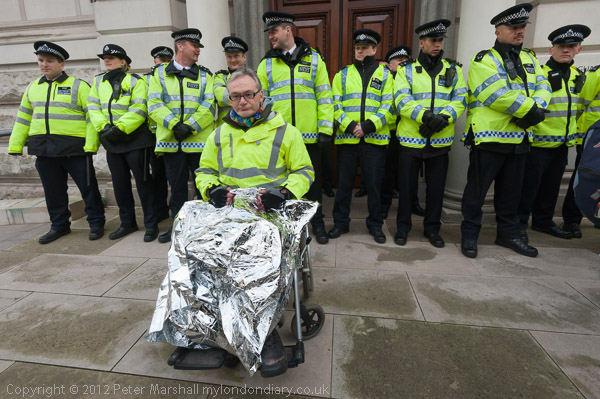
Police protect the Treasury door
more pictures
More than 50 from Fuel Poverty Action and disabled, pensioners and other groups protested outside the Treasury and Parliament against George Osborne's cuts and energy policies that are leading to 24,000 extra winter deaths.
The protest took place on the day that Energy Secretary, Ed Davey, was to introduce the Energy Bill to Parliament, although it was somewhat overshadowed by the publication of the report of the Leveson inquiry.
Fuel Poverty Action had organised the event along with Disabled People Against Cuts and the Greater London Pensioners’ Association. Other organisations taking part include Single Mothers’ Self-Defence, Southwark Pensioners’ Action Group and WinVisible (women with visible and invisible disabilities).
The protesters had brought plastic silver reflective coated 'space blankets' to wear and had three 'tombstones' with the messages 'George Osborne Your Cuts KILL', 'Gas Power = Killer Bills' and '24,000 Winter Deaths - Big Six Profits up 700%'.
The speakers at the open mike stressed that because of cuts in benefits and services, many people were now going hungry (and even the most prosperous areas have now set up 'food banks') and as winter begins more are now having to choose between heating a room in their home or eating. Even libraries, where many pensioners used to go mainly to keep warm are closing.
The cuts will increase the numbers who suffer from hypothermia, and the disabled in particular are hard hit, both because of the ruthless removal of benefits by poorly designed tests adminstered by poorly qualified testers with targets to meet and also because they often have special needs for heating.
The protesters ignored the police requests to keep off the Treasury steps and set up on them for photographs; the police then said they could stay there to take photographs and would then have to leave. The rally continued for a while, and then one of the protesters marched up the steps to the door waving her hot water bottle and saying she was going into the Treasury to keep warm. Police stopped her and after a minute or so the rally continued.
A few minutes later, police decided to clear the protesters from the steps onto the pavement, and when asking them had little effect the pushed them down, usually with minimum force, but just occasionally rather more than necessary, but both protesters and police generally remained calm. The protest continued on the pavement with more speeches, including one from Green Party leader Natalie Bennett.
By now there were over 50 protesters and they decided they would march to Parliament, and that on their way they would take advantage of the large crowd of media waiting outside the Queen Elizabeth II Conference centre for the publication of the Leveson report.
Police tried to move them on, but after a little discussion told them they had a couple of minutes to have some photographs taken - which was what they wanted - and they then moved off towards parliament. Police were happy with them going down to Old Palace Yard, but instead they decided to cross St Margaret St and protest on the pavement in front of Parliament. The police moved them back to ensure there was space for people to move past but let them get on with it for a few minutes.
An officer than rushed in to tell they they had to move as "a Royal
movement" was about to take place, an announcement that cause much
hilarity and comment but no movement, and they continued to protest in front
of Parliament. Then they were told that the royal movement was over and they
could stay where they were, but by then they had decided to go to Parliament
Square where there would be enough room for their photographer to take pictures.
So the protest ended with photographs taken on the grass of Parliament Square
with the House of Commons and Big Ben behind the protesters.
more pictures
Leveson Comes Out
QEII Centre, Westminster, London. Thu 29 Nov 2012
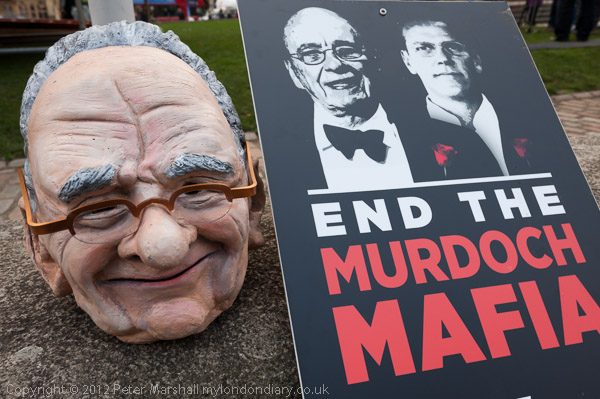
'End the Murdoch Mafia' - Avaaz protested outside the centre
more pictures
The media were out in force outside the QEII centre for the publication of the Leveson inquiry report, and protesters about the report and other issues came to take advantage of their presence.
Avaaz had brought large puppet heads of Murdoch and a gagged Cameron with
placards 'End the Murdoch Mafia' and a flaming dustbin into which Murdoch
lowered the Leveson report. Political artist Kaya Mar had brought one of his
paintings with the judge and a cart-load of people, though I couldn't recognise
them all. A protester from Kick Nuclear was walking up and down with his dog
which was wearing a poster about Fukushima warning of the dangers of nuclear
power. Later the Fuel Poverty protesters called in briefly too.
more pictures
3 Cosas - Sick Pay, Holidays and Pensions
Senate House, University of London. Wed 28 Nov 2012
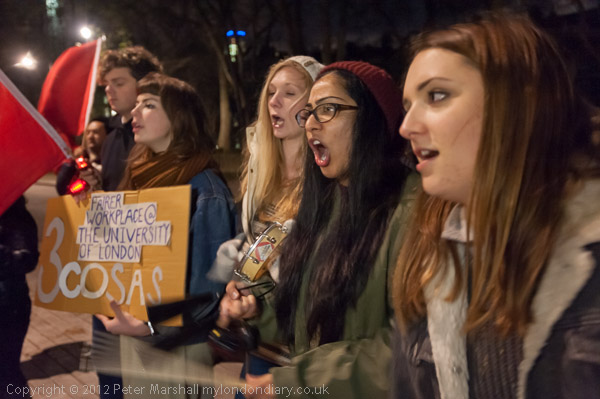
Students supported low paid university workers protesting for get sick pay,
holiday pay & pension
more pictures
Cleaners and other low paid outsourced workers at the University of London protested outside the Founders Day celebrations, calling for an end to unfair conditions and for equal employment rights - '3 Cosas' of Sick pay, Holiday Pay and Pensions.
The University of London’s central administration outsources its cleaning, maintenance, security, and catering services to Aramark for catering, and Balfour Beatty Workplace (BBW) for the rest. These companies then set their own standards for the working conditions and manage the staff. According the the workers, this means low wages, little or no sick pay, pathetic or no pension schemes, major pay problems, and lots of intimidation and bullying.
No reputatable employer - and certainly no university could get away with employing staff in the way that these contractors do, but the staff concerned are really no different from other workers in the university - it is their workplace they come to and many have been working in the same place for years. The university can't evade its responsibilities to these workers simply by getting someone else to run them - but that is what it is currently doing.
From 2010 to 2012, the contract workers at the university led by Unison campaigned to get all their members the London Living Wage. After a series of protests, during which membership of the union among them increased more than five-fold, the university finally agreed to implement the London Living Wage for all contract workers on the site. During the struggle the union also gained recognition by BBW.
The 3 Cosas Campaign for sick pay, holiday pay and pensions led by the Unison branch is supported by the cleaners' union, the IWGB, who were prominent in today's protest, as well as by students and academics. They have received messages of support from the University of London Union as well as from Green Party leader Natalie Bennett.
The protest outside Senate House was timed to coincide with the arrival of guests for the annual University of London Founders Day celebrations there. A protest last year in the living wage campaign caused Princess Anne to cancel her attendance at the event.
Over 50 protesters turned up for the start of the protest, including a number with drums to form a street band, while others brought banners and flags. Leaflets were offered to those attending the Founders Day, and many took them, though others brushed them aside. A student president came to talk to the meeting, saying he had been invited to attend, but was not prepared to cross the picket line unless the protesters allowed him to, promising to take in leaflets to hand out during the event. The protesters told him to go in and argue for their case and he went through the gates to change into his gown and attend the event.
We then heard that many of those attending had gone in by the back entrance
on the opposite side of the building, and the protesters decided to go ther
to continue the protest, marching around the block. They paused briefly at
a side door which was firmly locked, made a lot of noise for a minute or so
and then went around to the back gate to continue the protest.
more pictures
Save Carpenters Estate from UCL
University College, London. Wed 28 Nov 2012
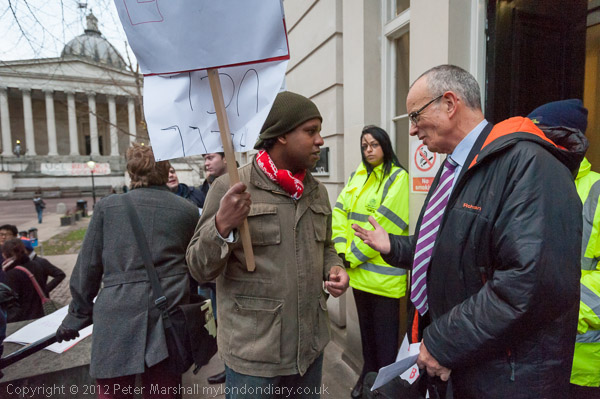
Joe from CARP talks to one of those attending the UCL
council meeting
more pictures
Residents from the Carpenters Estate in Stratford protested with students and staff from UCL today against the university's proposal to expel the community from their homes to build a new Stratford campus, approved by Newham council in October.
The Carpenters Estate in Stratford, on the edge of the Olympic site, is a popular place to live, a post-war council estate with low rise housing and several tower blocks close to Stratford station and the town centre. Some of the residents who moved in when it was built still live there. But its position and superb transport links make it a valuable site, and Newham council has been putting pressure on residents to leave so it can be put to other uses for some years.
Last month Newham Council accepted UCL’s £1 billion proposal to build a new campus in Stratford on the Carpenters Estate, displacing all the existing residents. The residents several years ago founded a group called CARP (Carpenters Against Regeneration Plan) who have been fighting to keep their homes on the site. Newham's reaction to tenant opposition was to get rid of those opposed to the demolition of the estate from the tenant's management organisation by underhand means, but most of those now in the TMO are also opposed to the UCL campus plan.
UCL has a enviable academic record in development planning and its DP Unit has issued a statement following a public meeting in September to discuss the UCL expansion plans which was attended by residents of the Carpenters Estate. This states "we believe that such an expansion should take place in a manner that supports and respects local communities" and calls for a review to be "undertaken on the basis of revised ‘site desirability’ criteria, to include a clear commitment to the well-being of local and East London borough residents, the active participation of affected communities, as well as engagement with local government." So far the plans appear to have been developed in private talks between Newham Council and the UCL behind the backs of those who will be affected, who Newham hoped to be able to get out of the way and way they could.
Around a hundred people attended the protest in the main Quad at UCL, including leading members of CARP and students and staff of UCL. After a few short speeches, the protesters moved to picket the main entrance to the building where the UCL council meeting had been rescheduled. CARP members were able to talk to a couple of members of the council on their way to the meeting, and also to some other members of the academic staff. One of the council members said that the university did not yet have fully developed plans and that there would be consultation with the residents before any development took place.
The protest was joined by more members of Unison and the UCU, who were also picketing the council meeting about proposed changes in academic contracts, in particular about 'Statute 18'; they say these changes threaten academic freedom.
The protesters then heard that the council meeting had been moved, and decided
to move their protest elsewhere, entering the university building. They walked
past the dressed skeleton of Jeremy Bentham to a meeting room and decided
that they would hold an altnerative council meeting there.
more pictures
Save A&E at Lewisham Hospital
Lewisham, London. Sat 24 Nov 2012
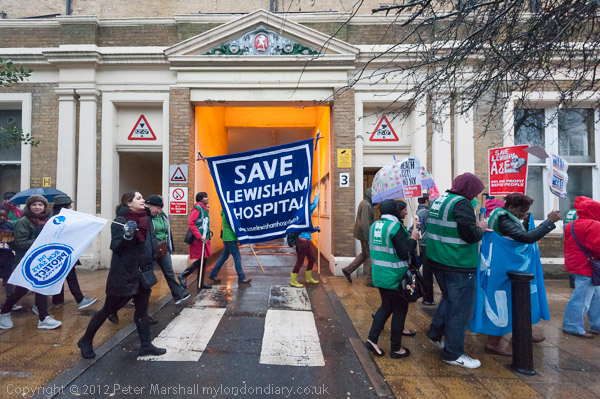
Medical staff walk past the old main entrance as they
form a human chain around the hospital
more pictures
Thousands of protesters - perhaps as many as 15,000 - marched through Lewisham to Lewisham Hospital where they formed a human chain to hold hands around their hospital to oppose plans to close its A&E department to pay debts from mismanagement at other hospitals in south London.
Despite the continuous rain there seemed to be well over a thousand on the march which left from near Lewisham station to walk though the busy shopping streets of the town on its way to Ladywell Fields and the hospital. At the front of the march with several banners were several hundred hospital workers, but as the afternoon went on, there were more and more arriving to take part in the protest with a packed road of people still coming to Ladywell Fields for the rally as I was leaving.
Shortly after the front of the march had made its way to behind the far end of the hospital in Ladywell Fields earlier I had been surprised when I looked back to see a stream of people still arriving. It seemed as if the wet weather had made many decide to come directly to the hospital to take part in the encircling of it rather than turn up earlier for the march.
The hospital workers set off to go around the hospital in an anti-clockwise direct while the others taking part in the protest went the other way, and eventually the two groups met in front of the main buildings of it on Lewisham High Street, with people filling the whole of the three-quarters of a mile 'holding hands' around the hospital. Although the organisers had asked for people to go in single file, there were far too many people in most places for this, and in some places the pavements were ten deep.
The Save Lewisham Hospital campaign made it very clear that they didn't want their protest to interfere with the normal working of the hospital, and ensured that the entrances and exits for ambulances were kept clear. But the number of people still flooding in after the hospital had been encircled meant that traffic on the High Street was brought to a standstill and nothing was moving along there or Ladywell Road when I caught a train from Ladywell.
The proposals threatening closure of the A&E and maternity services, and possibly also the the children's wards, critical care unit and emergency surgery come from the Trust Special Administrator for the South London Hospitals Trust, Matthew Kershaw, appointed by Health Secretary Andrew Lansley in July to deal with the more than £150 million loss made by the trust since it was formed in 2009. A major part of the problem arises from the disastrous private finance schemes entered into to build the trust's hospitals in Orpington and Woolwich which costs the trust over £60 million a year - and payments for which continue until 2032.
The Mayor of Lewisham has described Kershaw's attitude as 'cavalier' and
his proposal to drastically cut Lewisham Hospital and sell off some 60% of
it for £17million as 'disastrous', and on the march protesters were
chanting 'Mathew Kershaw get out, We know what you're all about, Cuts,
job losses, Money for the bosses!'
more pictures
Solidarity With Gaza, End the Seige Now
Downing St, London. Sat 24 Nov 2012
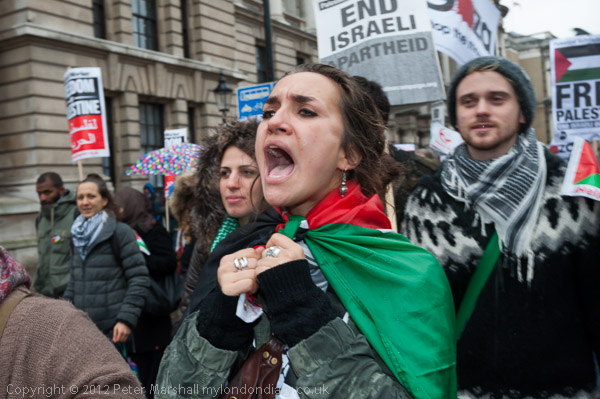
The march goes up Whitehall on its way to a rally in Hyde Park
more pictures
A protest march in London called for an end to the siege of Gaza and for freedom for Palestine and an end to Israeli state terror and war crimes. Thousands marched from Downing St to a rally near the Israeli embassy.
Several thousands turned up at Downing St in persistent rain to protest noisily against the recent Israeli attacks on Gaza and the continuing blockade which makes normal life impossible there. Although Israel claims its attacks are a retaliation for Palestinian rocket attacks on Isreal, the death toll shows the response to be totally disproportionate, with 163 Palestinians and six Israelis being killed before the ceasefire on Thursday.
The protest was called by Stop the War, Palestine Solidarity Campaign, CND and British Muslim Initiative, and was supported by many other organisations. There was a large crowd filling the pavement when I arrived, with several groups taking part in some noisy chanting of 'From the River to the Sea, Palestine will be free!' and other slogans, while others simply stood around waiting for the march to start.
As the time for the start of the march approached it began to form up on the north bound carriageway which had been closed to traffic. In front of the main banner were a number of children, and each was given a placard to hang around the neck listing the names and ages of some of the children killed by the Israelis.
Shortly before the march started, a large number of white balloons printed
with the Palestinian flag, one for each of the Palestinians killed, were released.
The march then set off, and I photographed the marchers as they went past.
Among those taking part were a number wearing 'Anonymous' masks, including
some from 'Occupy London' and also several Jewish groups including 'Jews Against
the Siege of Gaza', Jews for Justice for Palestinians and a group of Jewish
Socialist. As the end of the march moved out of Whitehall into Trafalgar Square
around 15 minutes later I left the protest, which was marching to a rally
close to the Israeli embassy where a wide range of speakers was expected,
to cover another event.
more pictures
Protest against Night Flights
Lampton Park, Hounslow, London. Sat 24 Nov 2012
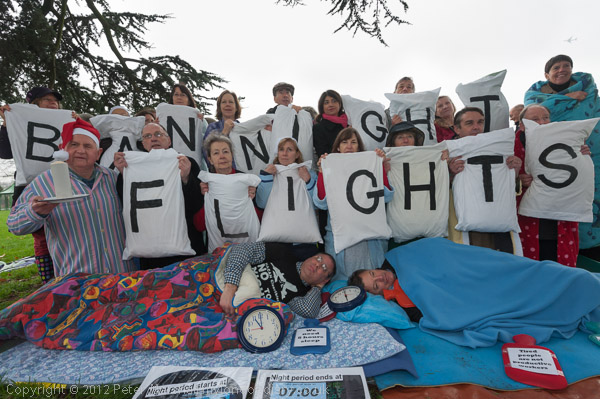
The pillows spell out 'BAN NIGHT FLIGHTS'
more pictures
HACAN staged an event close to Heathrow as part of a Day of Action against Night Flights taking place across Europe, calling for a ban on all night flights as the Government is expected to begin to consult on a new night flight regime.
Campaigners representing the views of many residents of Greater London fed up with the noise and pollution from planes landing and taking off at Heathrow posed for photographs under the flightpath in Lampton Park, Hounslow to show their opposition to night flights.
The event was part of a European wide day of action against night flights, and John Stewart of HACAN, the organisers of the event, had brough a banner from Germany which was displayed at the protest. It also took place shortly before the Government is expected to start consulting on a new night flight regime for Heathrow, Stansted and Gatwick. It took place despite the continuous light rain, although the perhaps kept the numbers low.
Some of the protesters changed into pyjamas or nightdresses, and others wore dressing gowns and other nightwear. One man carried a large candle, and there were clocks set at 11pm and 6am, the current times between which flights are described as night flights, although the campaign wants to ban all flights between 11pm and 7am to allow for 8 hour sleep.
As well as the German banner, other people held pillows each with a single letter to spell out the message 'BAN NIGHT FLIGHTS', and there were two men sleeping under duvets for the photograph.
The campaign for a ban on night flights enjoys widespread support, and as well as John Stewart from HACAN, Feltham and Heston MP Seema Malhotra also took part in the protest and spoke, along with a member of the Greater London Authority and the London Borough of Hounslow whose civic offices are next to the park.
Residents pointed out that aircraft noise prevented them from going to sleep in the evening and disturbed their sleep in the early morning, and that the lack of sleep had a deleterious effect both on their health and their work. They also complained that most people in the area had lost confidence in the procedure for making complaints about aircraft noise, and that most people had decided there was no point in making any complaints as these never resulted in any action being taken.
After the main photo session, there was a smaller group photo of residents
from Surrey, and then one of some of those present holding the flags of some
of the other countries taking part in the day of action, along with mugs with
the message 'No Night Flights' in their various languages.
more pictures
Students March on Parliament
Temple to Westminster. Wed 21 Nov 2012
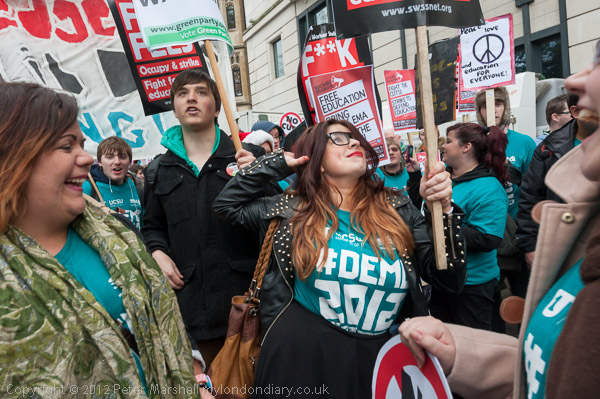
A student displays the #DEMO2012 t-shirt
more pictures
Students from across the country marched past Parliament in a show of anger against student debt, fees, lack of jobs, privatisation, broken promises & government attacks on education, calling for a new agenda for youth at the next general election.
Approaching 10,000 students gathered for a peaceful march through central London today against government policies and actions that have hit students, women and the disabled particularly hard. They are angry about the tuition fees increase, with most university courses now costing £9,000 per year from this academic year, over two and a half times the maximum fee for the previous year of £3,375. The average student starting a course today is expected to end up with over £50,000 of debt for their three year course. Living costs have also risen because of inflation, and many find the maintenance loan available isn't enough to pay for their accomodation and some need to take out more expensive loans than the student loan to keep alive during their course. Younger students, 16-18 year olds still in schools, sixth form colleges and FE, are angry at the loss of the Educational Maintenance Allowance (EMA) of up to £30 per week, which many needed to pay their fares to college and to buy midday meals while studying.
Another major concern is the lack of jobs, one in six 16 - 24-year-olds in England are now 'NEETS', not in education, employment or training in the middle of 2012 and the figure is likely to rise. Students are also concerned about other cuts being made by the government which will affect them, and also by the increasing efforts to privatise the education system at all levels. There were also many placards pointing out the class-based nature of our education system and our government, with a cabinet stuffed with privately educated millionaires who appear to have little idea of how difficult times are for ordinary people and no real sympathy for them.
Although the NUS had suggested that there might be around 5,0000 students on the march, the actual figure appeared to be a little larger, and they later increased their estimate to 10,000, perhaps a little on the high side. But it was certainly a large and generally well-organised march, with the organisers having agreed a route with the police which took the march over Westminster Bridge to a rally at Kennington Park.
The marchers mainly gathered on the Embankment at Temple, with others coming to join them in a feeder march from the University of London Union. Large numbers of police were on duty and the assembly point and some walked along with the marchers. At Bridge St where the march reached parliament there were barriers, police and a large group of police vans to prevent any of the marchers making their way towards Parliament Square. Earlier I had heard some groups of them singing about marching to Millbank where the Tory HQ was attacked by students a couple of years ago, but police were this time clearly determined to prevent this.
When the front of the march reached this point, a large group of marchers did run towards the barriers and the police, and there was a lot of shouting and pushing in the crowd, but I saw no violence. While the rest of the march slowly moved past and over Westminster Bridge on the agreed route, a samba band played close to the barriers and there was a great deal of loud chanting both about the student's greivances and also over the Israeli attacks on Gaza. At one point a small group of protesters attempted to block Westminster Bridge by sitting down on the roadway, but the road was in any case closed for the protest, so it was hard to see what they hoped to acheive. After around a half an hour the group on the road close to the base of Big Ben appeared to be drifting away and joing the other marchers, the last of whom where just passing by.
It seemed unlikely that anything further would happen - except it seemed
about to pour with rain - and I followed the marchers over the bridge, then
leaving them as they marched on to a peaceful rally in the park.
more pictures
Monday Blues
Paris, Mon 19 Oct 2012
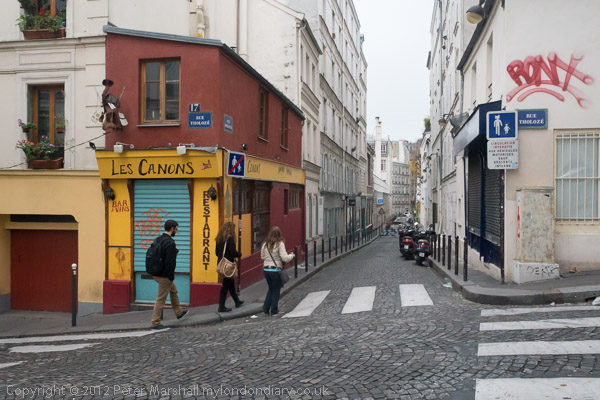
On our route to the cemetery in Montmartre
more pictures
Although Sunday had felt rather like the end, and my gut had put an end to all my plans, we still had most of Monday to fill before it was time to go the the Gare du Nord for the late afternoon train home.
My plans had been to go out for a good meal at one of our favourite cheapish restuarants in the 5e on Sunday night, with a few glasses of wine, then on Monday to book out of our hotel, leaving our cases to collect later, have a leisurely meander around a few of our favourite places, perhaps morning coffee in a cafe, then a little more wandering before a long and satisfying lunch, getting up from the table in time to collect our bags and walk to the station. But in my state I spent our last 24 hours in Paris eating nothing and drinking the odd sip of water - I just couldn’t stomach the thought of anything more.
But we needed to do something to keep myself and Linda occupied, and we started with a trip to the cemetery. Montmartre cemetery isn’t really a gloomy place, though it’s pretty huge, and gives considerable employment to the gardeners who were busily blowing the leaves from one place to another. We’d actually hoped to be able to walk through it and out a gate at the north-east, but on reading the notices found that this is only open on one day a year - All Saints.
So we just walked around a fairly small part of it, finding some of the graves of the famous who are buried there (even some I’d heard of) and generally enjoying the atmosphere. It must be about the best time of the year to visit, with falling leaves and colour on the trees.
We then had to walk around the outside of the cemetery to revisit the Espace Central Dupon, which now held a different show, Mectoub by Scarlett Coten, portraits of young Maroccan men in their own surroundings. On her web site, she perhaps unhelpfully writes:
“« Mektoub », littéralement : c’est écrit ”
literally ‘it is written’, but it more means that whatever is referred to is predestined, already written in the book of life. And perhaps in photographing these men in their work place or home we see them in acceptance of their fate, their destiny and their offering it to the photographer for her images.
But perhaps what is more obvious is her sense of colour, and their ease at posing for the camera. You can see the series on her web site, and what is striking both on the wall and there is the huge amount of pinks and red, dominating almost all the images. It was certainly an interesting set of portraits.
From there we hurried across Paris to the 3e, where one of the few shows open on a Monday was the work of Mariana Yampolsky (1925-2002) at the Instituto Cultural de Mexico. Tepalcates continues there until the 29 March 2013.
Yampolsky was born in Chicago but grew up on her grandfather’s farm in rural Illinois. Her father was a sculptor and painter of Russian Jewish extraction, and her mother came from a wealthy German Jewish family. A year after she graduated from the University of Chicago in social sciences she went to Mexico City to study painting and sculpture and fell in love with the country, making it her home and becoming a Mexican citizen in 1958. In 1948 she studied photography with Lola Alvarez Bravo and Manuel Alvarez Bravo, and the more interesting work in this show clearly showed his influence on her work.
The name of the show, Tepalcates, is apparently the Spanish version of a Nahuatl word meaning a fragment or scrap of rough clay, and is used to refer to anything made from clay, particularly dishes and bowls. Perhaps the clay here is the ancient culture of Mexico which Yampolsky recorded and also the clay that was important in the vernacular architecture prominent in the work.
For me there was far too much work in the show - and too little time to look at it all before the show closed for the lunch hour. There were some images that caught my attention, and rather too many that seemed to be little more than a record, perhaps something unusual or even typical and doubtless of interest to some but perhaps not to a general audience. But perhaps I’m not the right audience, not in love with Mexican culture. I think of the little curiosities that so attracted Edward Weston when he spent time in that country - and which for me seemed simply wasted film and wasted time when he could have been producing more of the great images he made there.
Yampolsky’s work I already knew - for example on Zone Zero and here and here - had perhaps led me to expect something more interesting. The gallery was closing for lunch, and it was time to leave before I had a really good look. But perhaps if I get back to Paris before March 29 I might go back and have another look.
Not that I wanted lunch. I went with Linda to a brasserie, but couldn’t face the smell or sight of food, and went to sit and read in the winter sunshine in the Square du Temple while she ate.
We did some more wandering in the afternoon, mainly by accident, and came upon the show Barcelone Annees 60, photographs by Narcis Darder Bosch (1923-2006) and Ricard Duran Bargallo (1916-1986) The PDF catalogue here has more pictures. Bosch was a succesful industrialist and a keen amatuer photographer, while Bargallo who started with an interest in cinema and painting and worked in the textile industry made photography his means of expression. While much of the work on show was very much in the amateur photography tradition, some of Bargallo’s work seemed more interesting.
Finally back at the Square du Temple we went inside the Mairie of the 3e, where another exhibition had opened that morning, Paris Couleurs 1960 by Jean Jéhan. A young man from the country, when he had to do his national military service he was stationed in Paris, and decided that after that he wanted to be a photographer. So he bought a camera and spent most of his off-duty time travelling around Paris and taking photographs on 120 film of the people he met on the street and anything that interested him. 200 of these colour images have now been published in a book, Paris-Bohème 1960, with a preface by Charles Aznavour.
From the large selection on show at the Mairie gave an interesting view of the city, which has changed considerably since then. He was photographing more or less at the time when I first came to the city, although I didn’t photograph it at all seriously until 1973. You can get a flavour of the work from the poster and a brief article on the show.
It was time to make our way to collect our suitcases and go to the station.
On the way we bought some quiches, in case either of us felt hungry on the
way home. I hadn’t eaten for over 24 hours, and it wasn’t until
I got back home around 8pm that I felt at all like food - and the quiche was
delicious.
more pictures
Sunday Afternoon
Paris. Sun 18 Nov 2012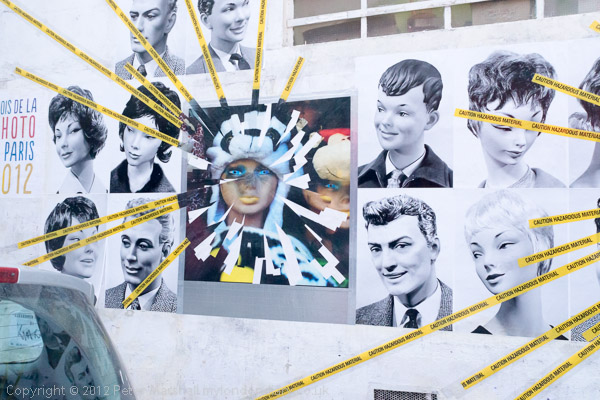
On a wall in the 3e
more pictures
By Sunday lunchtime I was definitely beginning to feel ill, but there were still things that I wanted to see, and after a brief lunch - a mistake - we went on to the Hôtel de Sauroy in rue Charlot in the 3e,where the first thing we saw was a rather curious box in the courtyard. It seemed a slightly odd way to treat the work of Liz Hingley, as the winner of the Prix Virginia for her work on The Jones Family, and certainly did not show it at its best.
The first show we went inside the rather grand house to see was Thanks to Luigi Ghirri & Italian Emerging Photography. I’ve never really seen what people see in Ghirri’s work, although it’s not entirely without interest, it has never really gripped me. What people see as poetic often seems to me just sloppy thinking and technique, but the work of the six younger Italian photographers held a little more interest.
For me the most striking work were the dark images of Alessandro Imbriaco’s Static Drama, but there was also interest in Marco Barbon’s Asmara Dream, Susanna Pozzoli’s On the Block. Harlem Private View, Ottavia Castellina’s Here I am Again, but I was less than enchanted by Claudia Pozzoli’s lonely mountains of metaphors and perhaps felt I had seen work similar to Margherita Cesaretti’s magic herbarium rather better done by others.
Through a neighbouring door leading to its own staircase we went up into the group show Le temps des lucioles (The time of fireflies) with work by Robert Cahen, Bogdan Konopka, Gladys, Laurent Millet, Sarah Moon, Caroline Hayeur, Machiel Botman, Didier Massard, Patrick Taberna and Salvatore Puglia.
The retelling of Hans Christian Andersen’s The Brave Tin Soldier is one of Sarah Moon’s most charming series, and it was good to see it on the wall. But for me the real star of the show - perhaps because I was not really familiar with his work before - was Bogdan Konopka.
Born in Poland where he was a part of a movement known as ‘elementary photography’ which led him to use a large format camera (mainly I think 4×5″) and work with low contrast heavily printed contact prints as a reaction to the then prevalent style of working, which favoured gritty high contrast and greatly enlarged photojournalistic images. He move to France in 1989.
The images on show demonstrated his approach, small and darkly printed with very little in the highlight area, they had an unusual depth and shadow separation that prevented them from being dull or gloomy. There were also copies of several of his books, and a comfortable sofa on which to sit and browse through them, so much that I perhaps neglected some of the other work on show which, at a fairly brief encounter failed to arouse my interest.
There is a good selection of work by Konopka on his Candace Dwan gallery page, although unfortunately the reproduction there seems a little unsharp and fails to do the work justice.
We walked rather briskly down to the Institut Suédois for a quick look at
the show Different Distances, showing the work of a new generation
of Swedish fashion photographers whose work has a free interpretation of fashion
and is also fine art photography. Or so I think the exhibition description
said, though to me it all looked rather ordinary. But by now I was really
feeling quite ill, and although there were more shows I had meant to visit
I had to give up and return to the hotel.
more pictures
Sunday morning at the MEP
Paris. Sun 18 Nov 2012
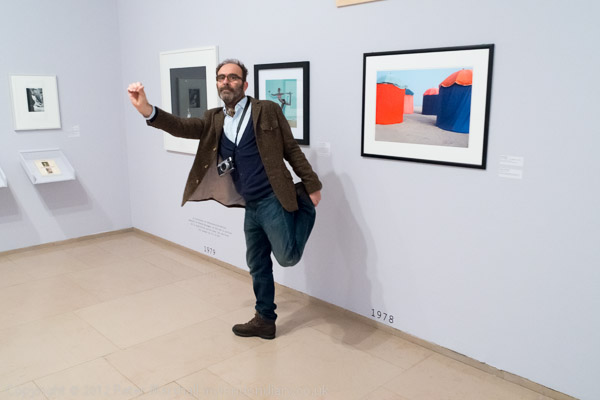 A
found a man in the MEP posing like the photograph behind him
A
found a man in the MEP posing like the photograph behind him
more pictures
Sunday I woke up not feeling at my best after a big meal the previous evening, but after a bit of breakfast felt a little better. Sunday mornings in Paris both Linda and I go separately to worship, she at the Protestant temple near the Louvre for the 10.30am service while I make my way to the Maison Européenne de la Photographie (MEP) in the rue de Fourcy in time for its 11am opening. Normally we then meet up for lunch.
Linda had already been to see the main exhibition at the MEP on the free opening they have on Wednesday evenings - when I was at Photo Paris. Photography in France, 1950-2000 was a large show which reflected both the changes in the medium and in society over the period and also the views of its two creators, Gilles Mora and Alain Sayag, who feel that photography is now past its peak, with the disappearance of much print journalism and the switch online to video.
The show certainly seemed to me to catalogue a downhill journey, with the show being dominated by the work from the early years, with some memorable images. Perhaps Iziz was the star of the show, but he had firm support from Willy Ronis, Cartier-Bresson, Doisneau, Brassai and more, with some fine fashion work by Frank Horvat and William Klein, as well as a rather irrelevant image by Robert Frank, a Swiss-born photographer who became American - although of course the publication of his book Les Amercains in Paris was a major event in photographic history in France as elsewhere across the world.
There were a number of books including this on show in glass cases - and this reflected the intentions of the curators to show photography in a wider context than simply images, and the show included examples of photography used in magazine spreads and adverts, as well as a grid of images of the best pictures by an amateur photographer packed with the usual cliches - sunsets, snow, sun on the mountains and sunsets - and one that almost manages to make a decent image of two hens. Perhaps the weakest aspect as an exhibition was in the display of books - looking at their covers isn’t a great experience, and perhaps some short video displays would have been useful.
But even in these heady early days there are signs of the fatal viruses that worked themselves out in the lower floors of the show dealing with the later decades. This was a history of a medium subverted first by the easy nudes and chemical abstractions and later by the philosophical and the chic, meaningless art and the market for such decorations. The show demonstrates both the strengths of French photography and its weaknesses.
What seems most dated from this early period was the work of the ‘radical artists’ who now don’t appear at all radical, while the ‘reclamé’ or publicity images have aged much better and made a real contribution to the show. It would perhaps have been better to have had a show of this nature curated by outsiders to French culture who might have spared us some of the more banal images of the famous French - and personally I could have done without pictures of our royal occasion.
As the years progressed there was still some fine photography, though it sometimes became hard to find for the dross (my notes have a rather stronger term.) Most of the better work came from the photojournalists, and the rest of photography - with some notable exceptions such as DATAR seemed to have lost the plot. Even those whose work I admire were often represented here by rather poor examples of their work.
This was a show intended to provoke discussion, and it will probably be very successful at doing so; it continues until 13 Jan 2013.
As usual there were several other shows at the MEP, the most interesting of which for me was Susan Paulsen’s intimate view made over 10 years of Wilmot, Arkansas, a small southern town which is a part of her family history and where some of her relatives still live.
I very much enjoyed looking at her pictures - finely made Epson Ultrachrome inkjet prints. They are very much seen from the perspective of her family, living in this town of 700 inhabitants, a town (at least for its white inhabitants) that used to be a place of “fine things, fine manners, fine ways.. a place where everybody spoke perfect English.” Changes came “in the 1960s; due to mechanisation many blacks were moving from the farms into town” and Paulsen records “I am proud of Uncle William and Big John for fighting … zoning restrictions” against setting up trailers (mobile homes) on the grounds that “trailers represent fairness to the very poor.”
The images chosen for the MEP web site show two portraits of black people in the nine images, giving a rather different view to the show as a whole. Although I went around enjoying the pictures, by the end I was also thinking it was a bit like comfort food and nostalgia and I longed for something with a little more edge. You can see some of Paulsen’s older black and white work older b/w work here.
There were a couple of other shows down in the basement, neither of which interested me greatly. One featured the self-portraiture of teenager Sarah N. who, according the curator writing on the MEP web site “has produced a staggering body of photographic work” and the other by Jean-Luc Tartarin, undoubtedly a talented photographer - he was only 20 when he won the Prix Niepce in 1971, the youngest photographer to do so, and who now teaches photography at l’École Supérieure d’Art de Metz Métropole. You can see some of his work on line at Galerie Jean Greset and see him talking at one of his shows on YouTube. But the work for all its technical proficiency didn’t have anything to say to me.
You can take a very quick walk around all these shows in a 1 minute 26 second video by Molly Benn on Le Journal de la Photographie. She also covered other events in the Paris Month of Photography, notably on the evening of November 8th, which was the peak evening for openings in Paris this month - the Photo-Off brochure lists 25 of them, but there were also 5 others. She got on her bike and tried to take in all 30, but was defeated by the long climb up the rue de Belleville and abandoned her ride after only 19, but still an acheivement that makes my own attempts seem rather tame.
Of course I like to spend enough time at each venue to see the work properly,
and also like to have a glass (or sometimes two) or wine, so even had I brought
my bicycle (certainly the fastest way to get around the city) I could not
have managed to come close to her record.
more pictures
Photo-Off Guided Tour
Paris. Sat 17 Nov 2012
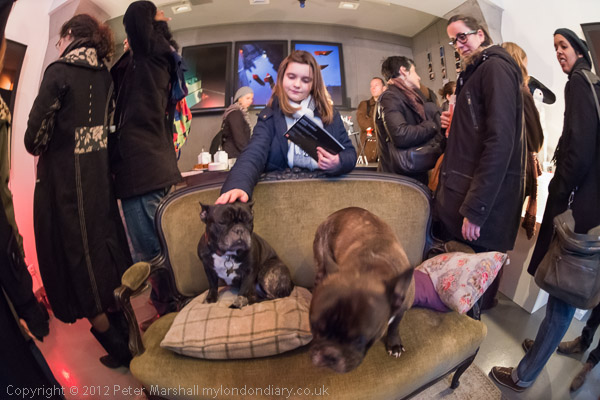
The tour at the Placement libre-atelier galerie
more pictures
One of the really good things that happens during the the Mois de la Photo are the guided tours of shows in the Photo-Off fringe festival. Two years ago we went on one of the first of these and found it really interesting, so we looked at what was on offer this year.
The shows in the ‘Off’ booklet (you can download it to see) are divided into ten areas of Paris, so you can fairly easily plot your own route around them, although if you try it can be very frustrating with the various galleries having different opening days and hours and different exhibition dates. But for the organised ‘parcours guidée‘, although they can’t quite cover all the shows in each area, you can be sure not only that the galleries visited will be open, but that someone - either the photographer, curator or gallery owner - will talk about the work and you will have the chance to ask questions. Of course the talks are in French, but I’ve usually found I can ask questions and get answers in English, and with Linda I have the services of an interpreter where necessary when my O Level (Grade B, 1961 and more than half forgotten) fails, though I’m still better than her if things get photographically technical.
There are 10 ‘parcours’, and the guided tours all take place on Saturday afternoons, and there were only 4 Saturdays in November so the last took place on 1 Dec. But that still means you can only go to half of them as there are two each Saturday. I chose to go on Parcours 3 (Le Marais - Turenne) because it was going to end at the NoFound Photo Fair which I wanted to see - and better still it included free entry.
We met at Galerie Sophie Scheidecker, in a courtyard off the rue des Minimes at 2pm; the show there was Pubart, a show of advertising and publicity photography from the 1930s in the USA to recent work in France, and including quite a few interesting examples - such as one of Duffy’s images from the iconic Benson and Hedges campaign; most but not all of the work on show was photographic and included a few images I hadn’t seen before. But my main interest was in the actual venue and the other buildings surrounding the courtyard.
Our next stop was Galerie Maria Lund on the rue de Turenne where there was a rather curious installation by Kwang-Wha Chung, Here! I found my car with a large split box, the lower half having a modelled landscape covered with plaster dust in which were embedded small model cars. Jets of what looked like steam and seemed to be fairly random disturbed the white dust creating miniature snowstorms which revealed and covered up the cars. On the walls around were photographs taken looking into this changing scene. It didn’t seem to me to have a great deal to do with photography, although of course the photographs froze and recorded a moment in this changing artificial micro-scene.
(Dés)Assemblages at Galerie ChipChop showed the work of three women photographers who in different ways produce images that are divorced from reality. Hélène Jayet combines overlapping exposures taken at different times and from a slightly different viewpoint on photographic film. Neta Dror from Israel sees the way she treats her images chemically to erase parts of them as some kind of antidote the the constant stream of news photographs flowing from her country. Canadian Amy Friend doesn’t take her own photographs, but uses family pictures and other scenes from the early nineteenth century, staining or otherwise altering the paper and punching holes through it to let through light so that the object is given a new life. The series name ‘Dare alla Luce‘, literally Give the Light, reflects the dual meaning of the Italian which according to the gallery text also means “to give life” or rather give birth.
At La Galerie Pascal Gabert we saw Nus, large fairly abstract studio nude images made using north light on a 8×10 camera by Jérôme Tisné, who spoke at some length about these images. The large prints are almost all either nearly black all over or nearly white all over, using extremes of exposure - up to 20 minutes, combined with some deliberate movement of the camera and extended development of the Polaroid colour film. The dark images seemed to me to have rather more subtlety of tone and colour, while the very pale works the blue sometimes dominated. Tisné made these works as a deliberate contrast to his long and successful career in press and publicity photography, but while I found the technical aspects of interest (and I hope I got them roughly right despite my language problems) I didn’t find the works particularly interesting as images. There were echoes of classic works - such as the nudes of Edward Weston, but I didn’t feel that the images had the kind of presence of his work and felt that perhaps the technique had rather become an end in itself.
Next came Joël Denot at NeC nilsson and chiglien in the rue Vieille du Temple. His work “concentrates on the medium’s fundamentals: colour and light” and indeed there is little else in these images with just a vague hint of the subject. The images seemed to me to be some kind of quasi-scientific inquiry into the properties of Cibachrome (Ilfochrome) or Polaroid, perhaps like the results which might (on a smaller scale) illustrate a laboratory notebook, or perhaps some kind of effort in reverse-engineering the process. But in the main it wasn’t work I could relate to as art or as photography.
Our next stop was much more to my taste, and the glass of tea and slices of cake we were given by Sandrine Maugein were welcome icing on the photography. The Placement libre-atelier galerie had a welcoming atmosphere and the work was full of humour and insight and a strong graphic sense. Frohlein.s “la femme invisible aux talons rouges” - the invisible woman in red heels - was certainly full of wit, if the message was at times certainly deliberately ambiguous. The red shoes certainly got around, and I think the statement like the pictures is full of plays on words and ideas.
Across the road Galerie LJ was like a small zoo, full of large animal sculptures, but it was the work in the basement we had come to see, Audur by Alix Marie, whose work combines performance and photography and unlike most such hybrids produces some interesting images. Born in Paris in 1989, she studied in London at Central Saint Martins College Of Art. Audur was the result of a residency in Iceland and shows characteristic, almost picture postcard images of the country but with the artist herself intervening in the scene. I rather liked the square lighthouse with its red and white stripes and Marie standing on the stones of the beach with her head hidden by a white box with red stripes. Also on show was work from another residency in Slovenia, where she worked in a deserted building producing Les éléments du décor, using her body and simple wooden boxes and objects, with images that very much reflect her involvement in sculpture.
Finally we arrived at the NoFound photo fair in the large Garage Turenne, which brings together all sorts of people with a real interest in contemporary photography. Here there was far too much to write about it all, but there was certainly a great deal of interest in photography among everyone I met, even if we didn’t always share the same opinions. Quite a lot of the work I didn’t find particularly interesting, but there was so much to see in the fairly short time I had that was just as well.
One particular set of work that stood out for me was by South African photographer Graeme Williams, whose essay Painting over the Present looks at the environments occupied by some of South Africa’s poorest people in small towns, townships and cities throughout South Africa. As he writes “although wealth and power have shifted hands since the first democratic elections in 1994, many of the benefits of these shifts have failed to filter down to grassroots level.”
Too soon it was time for us to leave as we had arranged to go out for dinner
though I did take a few pictures as we made our way towards our meeting place.
more pictures
Saturday morning
Paris. Sat 17 Nov 2012
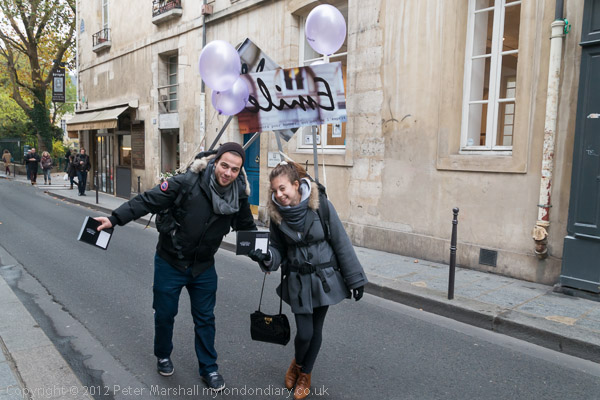 We
met this couple with balloons on the street
We
met this couple with balloons on the street
more pictures
One of shows open early (from 10am) on Saturday morning was Ilse Bing at Galerie Karsten Greve in rue Debellyme in the 3e. We had plenty of time after breakfast so decided to walk most of the way there from the edge of the 3e and on our way there we peeped through the large glass windows of a small gallery showing the work of Boris Mikhlailov; I decided it was probably not worth trying to come back to see it later when the gallery was open.
I found the Ilse Bing show a little disappointing. Not that the work was bad, but that there was really nothing that added at all to what I already knew of her work. Born in 1899, she abandoned her studies as an architect to become a photographer in 1928. She was one of the first to buy a Leica in 1929, and according to the information at the show introduced many other photographers in Paris to the camera. Apart from a few early images from Frankfurt her work is typical of the work of modernist photographers of the era. The pictures were mainly from her time in Paris, where she came in 1930, leaving for America in 1941 after having been interned in 1940 as an enemy alien. You can see a rather more varied collection of her work on Luminous Lint, where there is also a more detailed biography.
When I first came to Paris, much of the area around here was pretty run down, but now it is stuffed with galleries and design workshops, and although we were too early for some of them, and others were closed on Saturdays, there were still plenty to look into, and too many to remember.
One which was closed then, but which I was able to come back to for a quick look in the afternoon was Galerie David Guiraud in the rue du Perche showing Les Chefs-d’œuvre (the Masterpieces) of Louis Stettner. Some years ago I wrote about his work and in particular the fine images he made in Paris in the immediate post-war years. Although there were a few great pictures made after his return to American (and you can see a great deal of his work on his web site), it was clear from this show that this early period remained by far his most productive. There were two pictures showing a couple of children on the street hanging next to each other; the better known perhaps gives them something of an alien quality, and I prefer the immense vitality of the other image.
At the end of the rue du Perche La Galerie Particulière has premises on both sides of the street. The smaller was showing work by Michael Wolf but the larger hall on the other side was devoted to the work of Todd Hido, The enchanted realm (on show until 16 Jan 2013.) Hido, born in 1968 in Kent, Ohio, drives around America, and when he sees something that takes his fancy (and mostly this seems to happen on the edges of small towns) and takes pictures of desolate rows of houses, often in fairly dramatic light and other perhaps rather clichéd subjects. Some of the pictures are perhaps more about the weather, as he often seems to find the light he likes just after a brief storm and sometimes takes his pictures through a rain-spattered windscreen. Although I actually like the work, I don’t see it as anything particularly special, and certainly not something I would spend large amounts of money on or indeed hang on my walls. But perhaps I might occasionally take a look at a book of his work.
From there we made our way east to the rue St Gilles for a show by Daido Moryami at the Polka Galerie, with large (perhaps too large) prints of 30 previously unpublished images from his stay in Paris from 1988-90. They had a kind of shock value with their lack of mid-tones and subtlety, but also a different outlook that gave them some excitement, although I think his best work is from Japan. The high-contrast look was taken even further with the giant silkscreen prints that were on display in the office building in the courtyard behind the front gallery, and I felt these were perhaps too crude, at least when seen close to. Silk screen is of course essentially high contrast - you either print ink or you don’t (although using halftone screens can produce the illusion of continuous tone) and Moriyama obviously relished the opportunity this gave him. The silk screens remain on view until 12 Jan 2013.
It was time for an early lunch before the tour we were joining in the afternoon, and we found a bistro on the Boulevard Beaumarchais. Linda rushed to a table beside a radiator to warm herself up.
After our meal I sat in the Place des Vosges and logged on using the Paris
free wifi there to read my e-mail, while Linda walked round the square. Unfortunately
there still don’t seem to be many places with free wi-fi in Paris -
much less then in London, and although my BT account lets me use the Fon network,
there seem to be very few sites and when I found one it there appeared to
be no way to log in without paying. Neither the BT or Fon websites give any
help on how to use the networks abroad. But I was really too busy to spend
much time on the Internet anyway.
more pictures
Paris at Night
Paris. Fri 16 Nov 2012
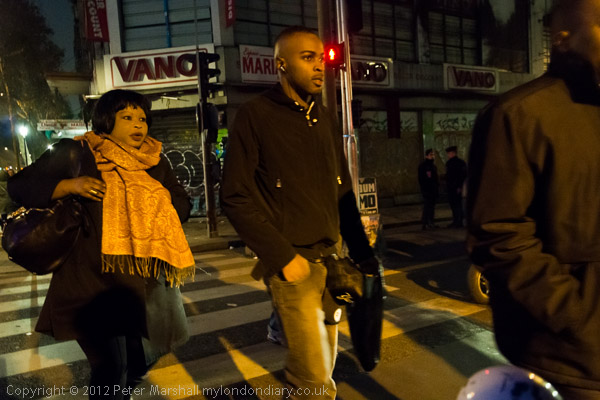
Barbès-Rochechouart - one of the few places where
there were lots of people on the streets
more pictures
We started close to our hotel in the 18e, but then took the Metro to the
centre of Paris and wandered around in the 5e and on Ile Saint Louis and the
Ile de la Cite. it was a chilly night, and away from the brightly lit streets
the city was pretty empty.
more pictures
Menilmontant
Paris. Fri 16 Nov 2012
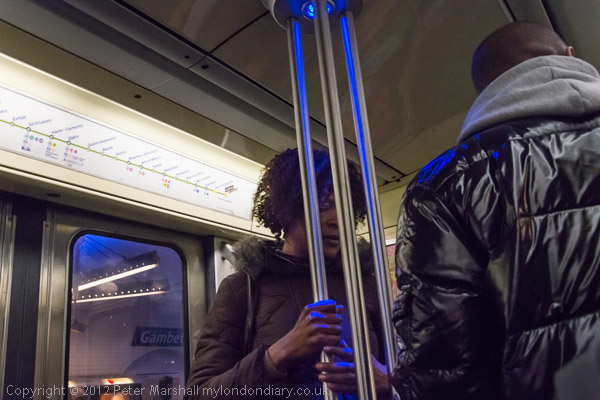
On the metro
more pictures
We took the Metro for the next show, but Ménilmontant is perhaps an unusual area of Paris, a large slab without a Metro station, though they ring around its edges, perhaps connected with its hilly nature. But I was pleased to have to walk up from Gambetta to the rue de Ménilmontant, as the 20e is one of my favourite areas of the city, although I didn’t have the time to wander as much as I would like.
It was a little hard to find the show we were looking for in the Pavillon Carré de Baudoin, though of course if you know it, then it’s impossible to miss, an impressive building, the only Palladian building in the area, built on a grand scale in several stages in the middle of the eighteenth century as a folly devoted to festivals and pleasures of the rich, and in 1770 it was given an impressive portico with four ionic columns. In the nineteenth century it became an orphanage run by the Sisters of Charity of Saint Vincent de Paul, and later they ran it as a young workers hostel and health centre. In 2003 it was bought by the City of Paris on behalf of the Mairie of the 20e who opened it as an arts centre for the community with a national and international presence in 2007.
But there was only a small notice by the gate telling us about the show which we missed at first as we walked along the street trying to find number 121, and it was another couple of hundred yards down the street that we found a building with a number on it and realised we had missed our way. But before we retraced our steps we were attracted by a short and picturesque street, the Cité de l’Ermitage, and went down this cul-de-sac to have a look.
Guillaume Herbaut’s show in the Pavillon Carré was overwhelming. It began quietly with a room containing Les Portes de Pripiat (2010), straight-on images of the doors of abandoned homes in blocks of flats in the city 3 kilometres from Chernobyl, showing perhaps the only remaining traces of the 30,000 people who had lived there. In the darkness of the next room was a showing of images from La Zone (2009-2011), Herbaut’s much acclaimed work in the forbidden area around Chernobyl 25 years after the disaster, and up the several flights of stairs was a room with some of these same images on the wall.
But the final part of the show had an intensity that is difficult to describe. 7/7 is a series of essays, a total of 95 images with short captions in seven stories that deal with some of the horrors of our civilisation and in particular with the effects that these have on environments and people: Vengeance killings under medieval codes of honour in north Albania; Oswiecim - the site of the extermination camp Auschwitz; Chernobyl again with the replacement town of Slavoutich - also declared contaminated in 2001, the survivors from Nagasaki, the second city to be devasted by an atomic Bomb, two days after Hiroshima; Ciudad Juárez, Mexico in 2007, one of the centres of the drug cartels, where more than 400 women have been murdered in atrocities since 1993.
There was a powerful atmosphere in the darkened room as people moved silently from image to image around the three sides of the large space. Some of the images were harrowing, but perhaps the most difficult were those that looked, at least in most respects so ordinary, so normal and even at times so beautiful.
If you read a little French it’s worth downloading the Press dossier from the Mairie site about the show, and it has a few images, though you can see more in the portfolio on Herbaut’s web site.
The show continues until 5 January, and is one that you should make time to see if you go to Paris. Herbaut, born in 1970 was one of the founders of the collective L’œil Public and has won various awards for his work. You can also see several videos, including one on the Zone from the links on his site.
I was still rather stunned when we came out on the street. It was a pleasant way to relax a little by taking a stroll down the Villa de l’Ermitage, often described as a haven of peace in the middle of the city, full of greenery. I’ve photographed it several times before on previous visits.
From there we continued along some of my (and Willy Ronis’s) favourite streets to the Bar Floréal, not a bar but another photography collective, founded in 1985 by three photographers as a studio, gallery and lab - and over the years the three have grown into a dozen.
Showing in the gallery there was Night and Day, the fine jazz photography of Jean-Pierre Leloir (1931-2010). You can read an obituary in The Independent, and also visit the official web site of his work. This show is on until 16 Dec 2012, and is certainly worth seeing if the subject matter - which includes some of the giants of rock as well as jazz - is of any interest to you, as it certainly was for me.
It was getting dark as we left, and we took a brief look for some nearby
shows that were a part of the Photo-Off, but saw rather little of them - it
was getting late and it was time to go and eat - and then to go out and look
at Paris at night.
more pictures
Friday Morning
Paris. Fri 16 Nov 2012
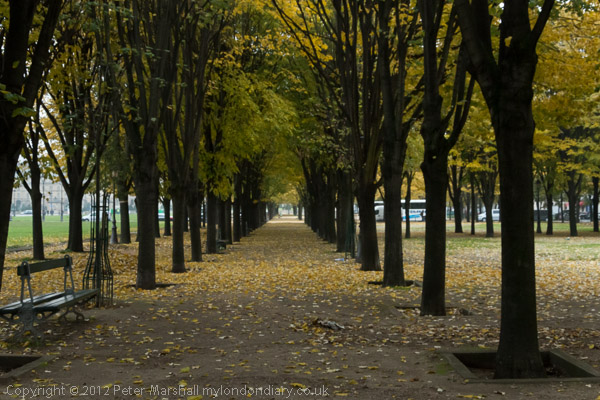
Esplanade des Invalides
more pictures
Looking at the images from Friday morning quickly brings back my memory of a cold morning with Paris in a cloud, damp and not quite raining as we made our way to the rue de Constantine in the 7e, not an area I much like. The show at the Centre culturel Canadien there, In the middle of nowhere, with work by Pascal Grandmaison, Isabelle Hayeur and Thomas Kneubühler continues until 22 March 2013, so is one of the few I saw in Paris that you can still see, though I don’t think it would be worth a great detour. The venue is certainly very grand, though I was a little surprised to have to go through an airport-style security check to view the show.
You can see more of Isabelle Hayeur’s work on her web site. The houses from her ‘Model Homes’ series were for me the most interesting part of her work on show, though they had a coldness that was unsettling, and somehow some looked more like Lego than real. There were also some of her large panoramic landscapes, I think constructed from digital images to create views that didn’t actually exist, but it didn’t really seem enough of an idea to justify the very large and slightly boring images. The works combining under and over-water views were perhaps a little more interesting, although mostly I was wondering about technical stuff when I looked at them.
Thinking about the show as a whole I felt the curator had perhaps tried to cram too many things into her concept of ‘the middle of nowhere’, “an unplaceable place—an absurdity, a paradox, a deception, an illusion, a brightmess—which represents a fabulous subject for photography.” I rather got the impression she had actually just chosen work that she liked from the three photographers which could then be mentally shoehorned into this rather vague idea.
Pascal Grandmaison’s work very little for me, with a very odd sculpture made using studio background paper, simply seeming to clutter the space it was in, and I failed to be impressed by a series of dull inkjet prints of deliberately empty images of what I think were fairly random pieces of ground. Perhaps there was a point to it, but I have to admit I failed to find it. Or was it just that these pictures were pictures of nothing much at all? If so perhaps it was in some sense a success that I thought they were not worth looking at, though really I think it was a waste of time.
Thomas Kneubühler’s work had considerably more interest for me, with a fine night image of a hydroelectric station and a curious series of distant views of illuminated mountains at night, ski slopes with the lights blazing away in darkness and reflected from the snow, and some large modern office buildings at night, enabling us to look into the illuminated offices.
From there we walked though the now slightly more particulate cloud across the Esplanade des Invalides to the main show I wanted to see, at the Fondation Calouste Gulbenkian, which was showing the European Photo Exhibition Award (EPEA), sets of work by Catarina Botelho, José Pedro Cortes, Gabriele Croppi, João Grama, Monica Larsen, Frederic Lezmi, Pietro Masturzo, Hannah Modigh, Davide Monteleone, Linn Schröder, Marie Sjøvold and Isabelle Wenzel. Three photographers under 40 had been put forward by four photography curators who themselves were selected one by each of four foundations - Fondazione Banca del Monte di Lucca (Italy), the Fundação Calouste Gulbenkian (Portugal), the Fritt Ord Foundation (Norway) and the Körber-Stiftung (Germany) who backed the award. They were then given 6 months to work on a project inspired by the theme of ‘European Identities‘ after starting with a workshop in Hamburg.
It wasn’t always easy to see any connection between the work on show and the theme, but there were some interesting pictures and projects among the twelve. You can see all the works on the EPEA web site, and the work is currently showing in Lucca, Italy and will be shown in Oslo in 2013.
Finally before lunch we called in for a brief look at Capucine Bailly’s Clichés de clichés, showing at the Cosmos Galerie until Christmas Eve. Born in 1980 and brought up in Paris Bailly went to New York when she was 21 and studied photojournalism and documentary phtoography at the ICP in 2004, after which with 13 of her classmates she set up the agency Veras Images. Now she is based in Paris as a freelance with Cosmos Agency - and you can see her work on their site. The ‘clichés’ in the show are rather fun and extremely garish, with the quality of mobile phone images treated to a psychedelic filter, and there were a few I liked a lot, particularly an image of a woman with very red lips during the election celebrations at the Socialist Party. But while I would buy it as a reasonably priced postcard or perhaps tear it out of a magazine to pin on a board, I wouldn’t want to frame it on a wall.
After another rather good brasserie lunch we walked past the Hotel des Invalides - now a military museum - and found there was another photo show to see on the wall facing the road. These were pictures from the Algerian war of independence, showing the Algerians who fought on the French side - the harkis - many of whom were massacred after independence. Although the large black and white prints looked interesting, they really were just a little too far away to have a real impact.
It was half mile or so to the Maison de l’Amérique Latine on boulevard Saint-Germain, where there was a very extensive show of the work of Cuban photographer Jesse A. Fernández (1925-86), De La Havane à Paris. Tours et détours, which continues until 28 Feb 2013.
You can do a quick 3 minute tour of the show on video, which gives some idea of the range of his work, with some interesting images from his native Cuba as well as the many fine portraits of artists and writers, made working with existing light. Fernandez was a fine photographer and his work should be better known, and this is a show well worth seeing.
There isn’t a great deal about Fernandez that I can find on the web,
but you can read a short
feature about him (in English) by one of the commissioners of the show.
more pictures
More Photo Off openings
Paris. Thur 15 Nov 2012
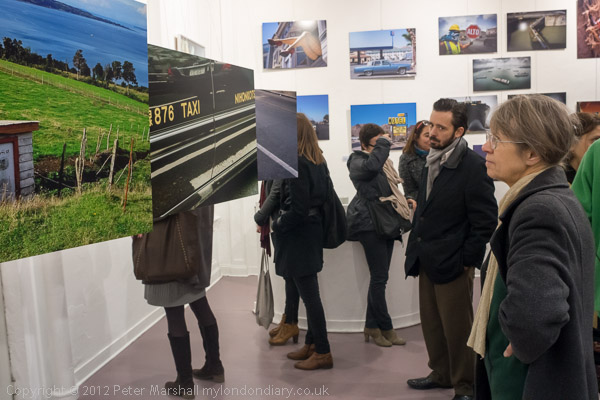
Linda looks at the work at Lieu37
more pictures
There were I think nine shows with “vernissages” on Thursday evening and I’d sat down the previous night and worked out a complicated route to visit half a dozen of them, finding short cuts on the complex system of routes which make up the metro system. But in the end I only made it to three.
Thanks to my seeing so many shows in the afternoon, we got off to a late start, rushing to the station and just missing a train. Of course they are so frequent this shouldn’t had been a problem, but although the next arrived three minutes later and we got on it, it moved no further. There were announcements, but none gave any idea of how long the hold-up was likely to last, and after ten minutes we decided to jump off and walk to the first show.
Lieux de passage (Crossing Points) at Lieu37 in the rue des Petites Ecuries in the 10e was a group show with 5 photographers, three of them professionals and two amateurs, photojournalist Christophe Lepetit, artist and director Frédéric Lemaitre, Grégoire Vopel, Jay Lag, and neurologist Yves Samson. It was, as the programme promised a deliberately eclectic show, and included some strange revolving triangular blocks with images on the three sides, as well as some highly enlarged i-phone images, which I felt would have looked better very much smaller, perhaps around postcard size. And although I couldn’t imagine ever hanging one of the images on a wall, I could see them selling well as cards for sending notes. The most interesting work to me was the blurred images of empty corridors and similar scenes, one of which is on the show site (image 9) but there are no details available there about it, and I seem to have lost the information I had about this set of work.
It was hard to get Linda away from the gallery and on to the appropriate metro station to take us to the next venue, Galerie Goutte de Terre on the rue Godefroy Cavaignac in the 11e, where the show was Krung Thep: la cité des anges, photographs by Pierre Raimond of street children in Bangkok (its Thai name Krung Thep means ‘city of angels’.) The photographer was accidentally invited into the world of street children in the city and produced some powerful portraits of them. After phtoographing them for some time he was refused permission to continue his work, but the children themselves were happy to have their pictures taken but with their faces hidden, and these images were among the most striking in the show. These were images that engaged me powerfully, and was one of the more interesting shows I found in those I saw in the fringe festival.
From here it was a fairly short walk to the next opening, A stone never dreams / Une pierre ne rêve pas at Le 19 in rue Trousseau (also in the 11e.) Franz Manni, born in Italy in 1973, has worked as an anthropologist in a Paris museum since 2000 as well as as a photographer, and perhaps because of his work has excluded people from these photographs, which look instead at structures and patterns formed in nature by human interventions. There was a strange quality to his images of patterns in water flowing over a weir or piles of materials by walls that intrigued me, though I find it hard to put into words why. These are certainly highly metaphoric images which Manni calls a way of reclaiming our dreams. In the gallery along with the pictures were some poems from the book Land of Stone by the American writer Karen Chase, in which Manni says he found the same spirit as his images, and one of which provided the title for his show:
I am a stone / a stone is good / it sits on a field / it never worries / it never dreams /
The poems in this book resulted from two years of weekly meetings with a severely withdrawn patient, in a locked ward of a large psychiatric hospital outside New York. Ben had given up speaking and social interactions and as therapy she engaged him in creating poetry. They would pass a writing pad to each other, taking turns in writing a line, engaging in a struggle for him to come out of his silence. There is perhaps something of a similar struggle evident in these pictures.
By this time the three openings had begun to take their toll (it would have seemed impolite not to have a glass or two of wine while looking at the pictures), and Linda had left me to go to a lecture and concert. I took the metro to go to the next show on my list, but when I got to the address could find nothing, not even a gallery and certainly no show. Probably I had gone to the wrong place, but I never found out.
I took a few pictures walking the night streets, which although dark should have been possible at ISO 3200, but few if any were sharp. My problem was the 20mm not focussing correctly. Although it is an f2.8 lens it seems to have a problem in lowish light on the D800E, though I’d not really noticed before using it on the D700. On autofocus it hunts very noisily noisily and excessively for focus at times; I’d noticed this particulary when photographing pictures at Paris Photo, when it often entirely failed to focus when I put a focus point on the picture frame (which I thought should make its job easy), but was usually better on the edge of the image. So much of the time I’d given up using it on autofocus, using scale focus and expecting the depth of field to cover any inaccuracy. But at night the focus scale gets difficult to use (its not much in good light) and it’s also very easy to alter the focus without meaning to. Especially after a few drinks.
I stood on the street outside where I thought the gallery should be wondering
where to go next, whether to spend longer trying to find the show or perhaps
to go on to the next. It was perhaps getting a little late to go on to the
next venue and I was hungry and tired and decided that this was perhaps a
sign to me that I should go and eat and then rest.
more pictures
Thursday Afternoon
Paris. Thu 15 Nov 2012
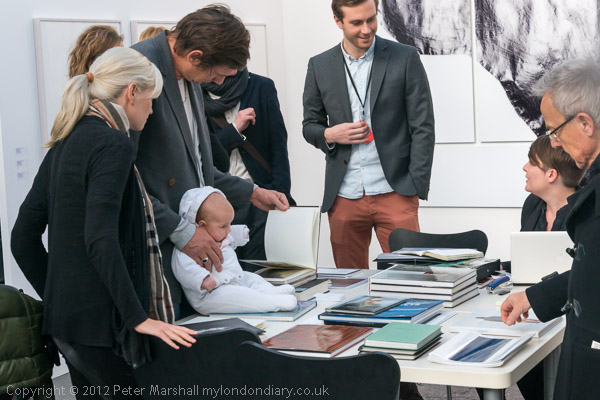
A young visitor to Paris Photo
more pictures
After lunch I took the Metro to Paris Photo - and this time I knew where the entrance was and the excessive security had gone - I simply had my pass scanned and walked in. I was also able to see the show of work by the Beckers, which I’d been stopped when I tried to view during the press launch. Predictably and perhaps appropriately it was extremely thorough and rather boring; though I admire the quality of their photography I find their overall approach with its rigid framework depressing.
But I’d soon completed my tour around the whole show, and was keen to get out and into the sunshine which had replaced the morning’s dull cold drizzle. I walked across the rather incredible and ridiculously ornate Art Nouveau Pont Alexandre III, like the Grand Palais opened for the Universal Exhibition of 1900 and along the Quai d’Orsay. Apparently I managed to drop 3 different “gold” rings that I had never possessed on the way, a common scam but this was the only place I came across it - and serially - on this visit. As I passed the Assemblée nationale the band of the Republican Guard marched out, but the traffic defeated me as I tried to cross the road to photograph them.
I was heading for the Institut de France, opposite the Pont des Arts, surely in danger of collapsing under the ever-increasing load of padlocks which are spreading from here across central Paris. These ‘love-padlocks’ are an ugly recent ‘tradition’ and I think a shame that the authorities don’t invest in some bolt cutters and remove the lot, though doubtless many will disagree; apparently they were removed a couple of years ago but have since sprung up in their millions. Perhaps Paris should follow Moscow’s example and provide some special iron trees for those who want to lock up their love symbols and adopt zero tolerance elsewhere.
In the Institut, l’Académie des beaux-arts was showing the work of Françoise Huguier, winner of the 2011 Prix de Photographie de l’Académie des beaux-arts - Marc Ladreit de Lacharrière. The prize enabled her to carry out a large-scale project ‘Vertical/Horizontal,Interior/Exterior: Singapore – Kuala Lumpur – Bangkok photographing the growing middle classes of South-East Asia. As well as being a part of the Mois de la Photo, this was also in the 2nd Saint-Germain-des-Pres Photo Festival which was also taking place. Hugier is well-known for her work in Africa and the far East, as well as for fashion photography, but I found this particular show just a little disappointing, somehow lacking a kind of decisiveness and focus.
Around the back of the Institut, galleries came thick and fast as I explored the roughly 35 venues of the SGdP festival in the rue de Seine, rue des Beaux-Arts, rue Mazarine as well as a several other shows that weren’t listed. Time was short, so some got only a cursory glance to establish I had little interest (and in some cases the view through the window or door was enough) but in most I went in and walked around.
There were far too many to list them all, but among those I found most interesting (in no particular order) were Bernard Plossu’s ‘Voyage Mexicain’ at Librairie Mazarine, Isabel Muñoz at Galerie Seine 51, a comparision of the American and Soviet dreams with work by Evgueni Khaldeï (1917-1997) and John Craven (1912-1981) at Galerie Aittouarès, Thomas Jorion’s ‘Palais oubliés’ at La Galerie Insula and a truly fine show of work by French photographer Xavier Roy, ‘J’ai toujours rêvé de découvrir le Brésil…’ There is more information about the festival in the press dossier.
But certainly the most impressive location, as well as some fine photography was at the Chapelle de l’Ecole des Beaux Arts, an interesting building recently renovated, where Robin Hammond’s project on Zimbabwe the prize winning entry in the 3rd prix Carmignac Gestion for photojournalism. The work too was stunning. Hammond worked for two years in the country and this April was arrested and held in jail for over three weeks for photographing without accreditation before released to leave the country.
My final call was at Galerie LWS for a show in the Mois, John Gossage’s ‘The Thirty Two Inch Ruler’ at galerie LWS. Published in book form a few years ago, this was his first project in colour, and they were impressive prints even though I found the overall series a little too bland. Its doubtless the subject matter, the comfortable private estate on which he and many of Washington’s most privileged live. There is a good piece on the book on Muse-Ings.
By now I was late, as I’d promised to meet Linda (who’d gone
to see a film) back at the hotel to go to some openings. But dusk was falling
as I rushed across Pont Neuf to the metro, and I couldn’t resist making
myself just a few minutes later by taking a few pictures.
more pictures
Thursday Morning
Paris. Thursday 15 Nov 2012
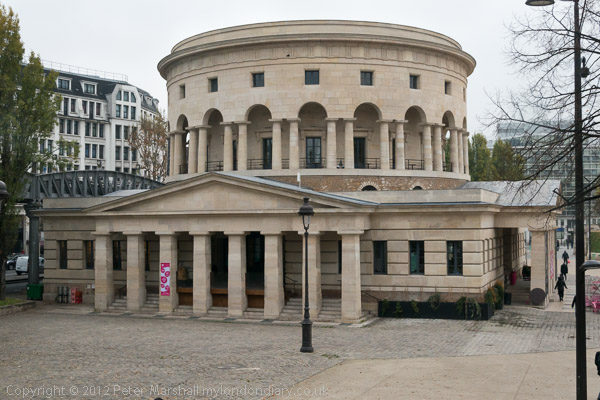
La Rotonde de la Villette
more pictures
Paris Photo doesn’t open until noon, so I had the morning to see some shows outside before returning to continue my work inside there. I suppose the kind of people who buy photographs don’t like to get up too early - or perhaps there is some other reason for them keeping the hours they do. I suppose it does mean some people will come on there after work as it stays open until mid-evening.
It was raining slightly and rather cold as we left our hotel and walked to the Place de la Bataille-de-Stalingrad, where I’ve previously been many times to admire one of Paris’s great buildings, the Rotonde de la Villette, a classical cylinder designed by Claude Nicolas Ledoux and built shortly before the Revolution as the offices for the tax collectors and guards who took the taxes on goods entering Paris. Now it’s been renovated and La Rotonde is a restaurant, but I’d not come here to eat but to see a Magnum show that was about to finish which was on the open area between it and the Bassin de la Villete.
Surrounding a large closed tent were a number of double-sided stands, linked to the tent by a like the tentacles of an over-legged octopus. Each of the 36 carried a series of pictures of a young entrepreneur, the founder of a micro-enterprise, and they incorporated loudspeakers which told you their story. The photographs, as you would expect from Alex Majoli and Jonas Bendiksen, were competent, but this was largely good commercial work than portraiture with more depth. I listened to a couple of the stories, then left Linda listening and walked around the area taking more pictures.
The area has been tidied up a lot in recent years, and what was once a slightly disreputable place is has gone up considerably in the world, although with many of the old canal-side buildings having gone and new modern offices and other buildings having sprung up it is rather less interesting. Some find the métro aérien whose viaduct goes across the square ugly, but it is certainly truly Parisian, and I rather admire its heavy nineteenth century ironwork.
The trees are covered with bright yellow leaves - its the time of year when once I used to hide the colour film and work only in black and white, there are only so many autumn images I ever want to take - and I indulge myself a little, before turning back to the austere pavilion.
Eventually Linda has listened to enough of the stories and we leave, walking south down beside the Canal St Martin, past a couple of locks to one of my favourite Paris views - I have a salt print I made years ago hanging in my living room (I don’t quite go back to the Fox Talbot era, but got interested in trying out the historic processes including salt printing, platinum, gum bichromate, cyanotype and more that I had to mention in the history course I taught.) I like to go back there and see how it has changed and also try to make some slightly different views.
At this point I lost Linda who had gone to look at the park opposite while I was taking pictures, and I found I couldn’t get a signal to phone her. Eventually I saw her in the distance and we met up, but by now it was rather later than I’d expected, and we walked quickly down to the Place de la République, close to which were several galleries which were open from 11am. I’d written down the address of the first with the wrong street number, which made it hard to find, but being Paris, we found two other galleries with unlisted shows first, which were actually slightly more interesting.
Our next stop was one of Paris’s nicer galleries, la galerie Les Filles-du-Calvaire which was showing Corinne Mercadier’s Devant un champ obscur. The lower floor (above) had a series of large colour prints of scenes taken in what seemed to be an empty and deserted building, all of which had been inverted to a negative.
On the upper floor were staged images, some involving people with blocks or balls. it wasn’t really my sort of work. There is what seems to be a full set of the images on the gallery site, and if like me you are curious about the negative images you can copy them and drop them into Photoshop and then invert them (Ctrl+I). Of course I wouldn’t dream of posting Mercardier’s images treated in that way here, but here’s a more or less random image from my own collection (actually a crop from a panorama I was working with yesterday) treated in the same way. The clouds certainly gain in menace.


Gravesend, 2000
I know of photographers who always scan their transparencies as negatives and then invert them, claiming that with their software and hardware they get better results, though I’ve never found that to be the case. But certainly the negative world is a rather strange case as many photographers know, and back in the days when we all used black and white film we got quite adept at mentally flipping negatives to visualise the positive they would print. Colour negatives added a different dimension (and an orange mask) that made this - at least for me - largely impossible.
The first negative prints in the world of photography of course date from before W H F Talbot, who produced them in camera in the 1830s as ‘photogenic drawings’ (and a little later as calotype negatives), to the cameraless experiments of Wedgewood and others, and at Paris Photo there were a few examples of prints from the earliest photographically illustrated book, the splendid Photographs of British Algae: Cyanotype Impressions by Anna Atkins which she started to publish in 1843.
Mercadier’s large negative images were made from much more subdued subject matter than my trivial example, and the large expanses of white wall in the deserted building result in very dark images, powerfully so. They had a presence that I found lacking in the dream-like staging in her works in the upper gallery, which to me bordered on the ridiculous, a kind of game-playing of ultimate insignificance, bolstered by the kind of philosophical statements which the French education system glorifies and inducts.
It was time for an early lunch, taken in a brasserie full of Parisians, many
noisily celebrating the arrival of the Beaujolais Nouveau, a triumph of advertising
over common sense and taste. I had to work in the afternoon and stuck to a
single glass of beer with my extremely tasty plat du jour, Beef bourguignon
with some deliciously cooked pastry wrapped potatoes and bread, though a red,
but certainly not Beaujolais Nouveau, would have been even more appropriate.
more pictures
Paris Photo
Paris. Wed 14 Nov 2012
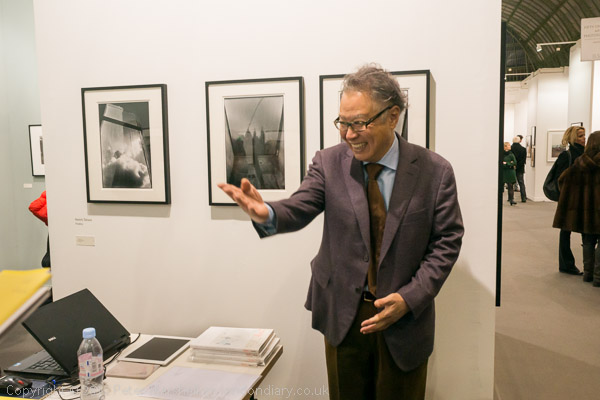 Japanese
photography made a strong showing - including images of Paris
Japanese
photography made a strong showing - including images of Paris
more pictures
Wednesday afternoon was the press preview, followed by the ‘vernissage’ and I’d already applied for and received my press pass, so all I had to do was to find the entrance. It took me a little while, as I started by finding the very long queues for the Hopper exhibition and then turned in the wrong direction, managing to walk virtually the whole way around the outside of the building (and its a very large building) before finding Paris Photo. After managing to get into the steps leading down to the show I was then sent back to find the press entrance, where I was given some documentation and finally, having had by then half a dozen security men wave readers at my card, magic wands over my body and peering into my bag was allowed to enter.
I decided to start by trying to see every stand, walking around the show in a logical fashion so as not to miss anything, stopping when I saw anything that interested me, and taking notes, but the magnitude of the show soon defeated me, and too often my handwriting does also.
So the comments I’m going to make are somewhat fragmentary, and don’t really represent the show as a whole, but are some of the highlights, and in particular will concentrate on a few things that were new to me. Take it as read that there were many good - if now familiar - images by many well-known names, as well as a great deal of work that I found without much if any interest (and much of it printed very large in colour.)
On the Robert Mann stand, some black and white work from the last decade by John Mack in Mexico stood out, with some strongly graphic images, though perhaps a little old-fashioned. Nothing wrong with that and some of the best work there was from the 1930s in Paris by Fred Stein. They also had one of the few good Robert Frank prints in the show.
At the galerie Le Réverbère from Lyon there were several photographers of interest new to me, and I particularly enjoyed the work of Géraldine Lay (b1972), Les failles ordinaires, a series of images of ‘fault lines’ in ordinary reality, some of which have a rather Hopperesque quality. You can see more of her work on her web site. They were also one of several stands to be showing work by William Klein, and you there is a link to an interview with him on the Lensculture blog which I watched yesterday.
Another stand which caught my interest was Gungallery from Stockholm, not just for the work by Anders Petersen, largely familiar to me, but for a group of pictures by Gerry Johansson. You can see work from his various books on his web site, including Deutschland. Looking at his work I immediately thought of Robert Adams, and picking up the book Oglunda and opening it I found myself reading an appreciative foreword by Adams.
One area was devoted to the 30 short-listed books in the Photobook of the Year Award, and I’m pleased to hear that Anders Petersen’s City Diary - three straightforward volumes of photographs which to me stood out head and shoulders above most of the rest for both the quality of the photography and for the simplicity and effectiveness of its design - was the winner. Some of the others seemed to have been selected simply for their tricksy design despite the often banal images, and at least one seemed to lack all the basic qualities of an actual book. Out of the 10 there were only perhaps two or three I would have made space for on my shelves had I been sent copies for review - including those by Lise Sarfati and possibly Stephen Shore - though I didn’t think the print on demand volume showed his work too well. Overall, the standard of the First Photobook Prize was perhaps higher. Although I wouldn’t myself have picked the winner, David Galjaard’s Concresco, it was an interesting set of pictures. Other interesting books were by Lucas Foglia and Jerome Sessini, and Cristina de Middell deserved a prize for humour for her images of the Zambian space program. She has just been announced as one of those short-listed for the 2013 Deutsche Börse photography prize. Though I hope it goes to Chris Killip, it seems unlikely and I can only agree with Sean O’Hagan about that and the nomination of de Middell.
The Magnum stand was perhaps a little disappointing, though a collection of images by Raymond Depardon mainly taken in the San Clemente Psychiatric Hospital in 1979 stood out.
There were tributes to Louis Stettner, marking his 90th birthday - and most of his best work was from his early years in Paris, so this was a fitting place, as well as to Martine Franck who died in August, aged 74.
Other shows within the show included one from the J P Morgan Chase Art Collection. It started well, with a couple of Cartier-Bresson’s best (and one also-ran), and a couple of good Walker Evans images among his four and the same for Robert Frank. 11 by Eggleston seemed rather too many for such a small show, and then there were four Friedlanders and 3 Winogrands. After all this, the portrait of a farmer by Eve Arnold and two by Lynne Cohen came as rather an anti-climax. It looked as if the curator had got to that point and suddenly realised that there were no pictures by women in the show and searched desperately for anything that might fill the gap. Surely there are better images by women - these women or others - in the 6000 in the JP Morgan collection? Perhaps an Arbus or two and a Nan Goldin?
As usual many of the best colour prints on show, and quite a few of the black and white, were inkjet prints, though there were at least one hundred and one ways of making that less obvious to the label reader (and far too many pictures that didn’t have any label, as well as some that you would have had to get on your knees to read.) But there were vintage C-types, almost always recognisable by an overall orange or brown cast as they continue to decay, though this does not yet seem to have affected their prices.
There was, as in previous years, some interesting Japanese photography on several stands, and I was also amused by the photocollages of Toshiko Okanoue, at the Third Gallery Aya from Osaka which was showing the work of 4 Japanese women, with Ishiuchi Miyako, Yamazawa Eiko, Akasaki Mima and her.
There was so much more. Kertesz, another photographer who made Paris his home, had work on so many stands, but particularly on that of Vintage from Hungary. Weegee too came up on several, there were a few by Leon Levinstein I don’t recall having seen before. The Feroz Gallery, founded by Julian Sander, great grandson of August Sander had a nice wall of grandfather’s prints, while another stand had an unfortunate collection of bad copies made by Sherrie Levine, along with her lousy copies of Walker Evans, work which I can’t accept has any validity or place on an exhibition wall - the only place it belongs is as an exhibit in a copyright court.
By around 7.30pm I was exhausted, and since no-one seemed to be offering me
any of the champagne they were drinking I decided it was time to leave and
get something real to eat and drink.
more pictures
Wednesday Morning
Paris. Wed 14 Nov 2012
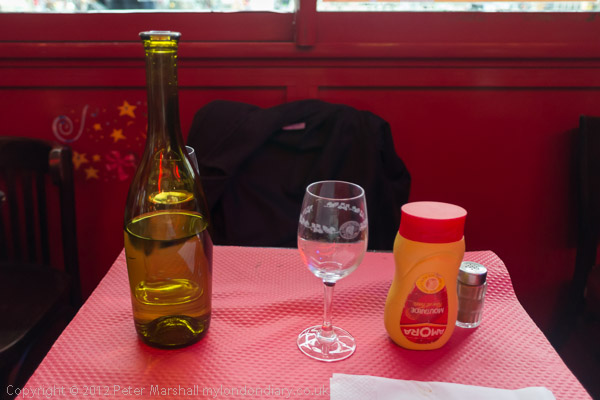
After Lunch
more pictures
Fortunately I’d been able to pick up one of the Mois de la Photo OFF booklets at the Speos Gallery the previous evening, as this morning although I could log on to the hotel’s wifi it wouldn’t give me Internet access. Linda had also bought a copy of the Paris listing magazines which also had most of the major shows, so we were able to make some plans for the day.
While on line the previous day I’d noticed that this was the last day for one of the shows in the Mois de la Photo, and as it was, like our hotel, in the 18th arrondissement and open from 9am we decided to start there (though a little later in the day.) It would have been a longish walk so we took the Metro, and then sat for a while in the park next door to the lab enjoying the atmosphere (with a sound track of screaming infants playing on the swings) and eating a croissant or two before going in to see the show at the Espace Central Dupon, one of Paris’s best pro labs.
The show there was by a collective called Transit, celebrating their ten years of existence since they were founded in 2002 by Nanda Gonzague and David Richard - who were later joined by Bastien Defives, Alexandra Frankewitz and finally Alexa Brunet, and the text suggested that such loose collectives as this might be particular to French photography. I wasn’t sure about this, but it was an interesting thought, and some years ago I’d written a couple of pieces about a similar grouping, ‘Tendance Floue‘ (and last year here) which was referred to in the wall text as setting the pattern for such groups.
The show itself had some interesting work, some dealing with issues that I’ve also been involved with such as anti-capitalist protests and staged events, but with a truly annoying lack of captions. After some minutes I discovered a single double-side sheet on a table to the side of the show which had thumbnails and brief captions, and photographed it. Even this was defective, in particular that it didn’t tell you which of the photographers had taken the picture. It would have been rather better to have had captions on the wall next to the pictures as they were essential to appreciating the work. There are pictures that don’t need captions - but these certainly did.
From there the Metro took us to a show where I was confident of being able to pick up the printed brochure about the Mois de la Photo, at the Maison de l’Architecture en Ile-de-France, which was showing Jean-Pierre Porcher’s ‘Le Corbusier, Une Promenade Picturale‘.
The images were large colour semi-abstract works made in some of Le Corbusier’s buildings, and it was possible in some at least to see the connection between the images and the buildings in which they were made, with some recognisable elements. Some were hung on the walls, but most were displayed in frames laid horizontally or at a slight tilt on top of a number of tables in the middle of the space.
The high quality inkjet prints certainly had a powerful presence, and were notable for the purity of their colours, though for me the effects, perhaps produced through multiple exposures and other tricks of photography were somewhat at odds with the clarity and precision of modernist architecture. The colour too in some images perhaps reminded me more of Mondrian than Le Corbusier. Again the captions were separated from the works, which were numbered but apparently displayed in fairly random order, making it a little difficult to find the several images based on the building with which I was most familiar, the Villa Savoye at Poissy, having photographed it myself a few years ago.
And as expected, I was able to pick up a printed copy of the programme for the Mois, an essential document for the rest of my visit. Of course the Mois has a good web site, but the logistics of going to see shows is complicated by dates and is opening days and times. Most smaller galleries only open in the afternoons, and are generally closed on Sundays and Mondays. Most places are closed on Mondays but shows that take place in business premises are generally open from Mondays to Fridays from some time in the morning until around 6pm. Lots of places are open on Saturdays, rather more on Saturday afternoons and rather fewer on Sundays - mainly in the afternoon. I think the well-prepared visitor would set up a spreadsheet or data base and spend several weeks planning their visit, but I use more primitive methods - like going through the booklets about the Mois and scrawling M for morning, SM for Saturday and D for Sunday at the side of appropriate entries. In previous years I’ve downloaded and printed out a PDF version to plan in advance, but this year I’d been too busy.
A second reason for going to the show at the Maison de l’Architecture was that it was on the way to the bistrot where I wanted to eat lunch, somewhere in the 20e, though it gets crowded enough without me giving it a free advert. Another thing I’d forgotten to do before I came to Paris was to check exactly where it was, but fortunately it didn’t take too long to find.
Afterwards we took a short walk to our favourite Paris park (full or larger
screaming kids taking part in some sort of race), looking rather good in Autumn
colours, before I decided it was time to make my way to Paris Photo.
more pictures
Openings - Tuesday
Paris. Tuesday 13 Nov 2012
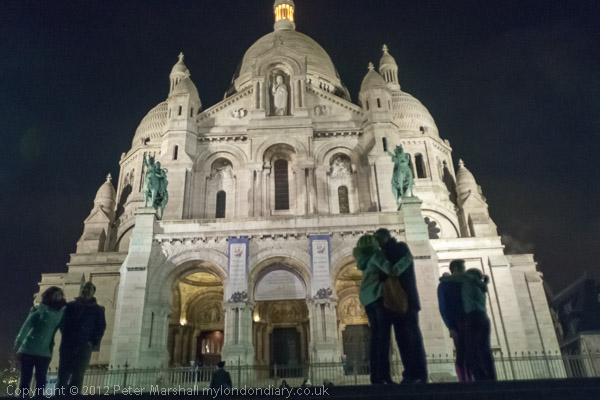 Yes,
I was really in Paris!
Yes,
I was really in Paris!
more pictures
We arrived at our hotel in Paris a little after 4pm, having left home around 5 hours earlier. The first thing we did when we arrived at Paris was to recharge our Navigo cards; rather like an Oyster card in London, but the 7 day fare is only available to cover Monday-Sunday, so we lost out slightly by buying it on a Tuesday. But since it costs roughly half the price of a similar Travelcard in London we weren’t too bothered.
We actually walked to the hotel, which I’d chosen because it was cheap and close both to the Gare du Nord where our Eurostar arrived and to a very useful Metro station. It was in an area I knew well, and one which has a fairly unsavoury reputation, but we’d stayed around there before and it hadn’t been a problem. And the hotel turned out to be reasonably comfortable and very quiet, despite being only a short distance from a couple of main roads and the Metro line.
Having taken my usual 2 minutes to unpack, out came my notebook computer, and after finding the hotel’s wifi password I was able to get online and on to the site for the Mois de Paris Photo OFF to check up on the events that I knew were taking place that evening. Fortunately on this occasion I managed to get a connection, as stupidly although I’d looked up the events a couple of days before I hadn’t noted down the details, and I had no printed documentation.
The Photo-OFF has a great web site, though only one page of it is in English, which tells you what it is: ‘The Mois de la Photo-OFF is organized by Paris Photographique, a non-profit structure specialized in the organisation of fine art exhibitions that showcase the work of emerging and established, independent, contemporary photographers. Organised by photographers for photographers, the aim of our exhibitions is to encourage emerging photographers to exhibit and sell their work‘ and just a little more, including the fact that there is “no other documentation available in English.” But you hardly need it as the rest is pretty obvious, although the translation feature of Chrome came in handy for the statements about the shows. As well as listings of all the 100 shows in the festival with pictures, details and maps it has a great calendar of events day by day, from which it was easy to find the four openings that were taking place that evening. Three of them were in roughly the same direction and we decided to go to these before finding a restaurant for some dinner.
Görkem Ünal’s Mythologies was showing at the Speos Gallery in rue Jules Vallés in the 11e, opposite the Spéos Photographic Institute where she teaches studio photography. Born in Instabul she spent some time in the USA before settling in Paris ten years ago.
I found her work difficult to relate to, and the text that accompanied it, with sentences such as “Just like mythologies working in silence, the images of Görkem Ünal allow emptiness to exist as energy; energy of anticipation, of a secret foreseen which renders the mystery active” didn’t help me. Although I found some of the individual images interesting, and there were some links both graphic and in terms of subject matter between some images to create a sequence the photographs for me didn’t become “the mirror of the soul.” But perhaps I lack the kind of soul necessary for this work. Ünal has a blog on which you can see some more work, as well as a website.
Our next call was at the Galerie OFR for ‘Insight Paris‘ by Gianluca Tamorri, born in Rome, who came to Paris in 2005 and began this project, self-publishing a limited edition book ‘75003‘ with 48 photographs in 2011. Although I found the show with only 13 images rather disappointing, it looks a lot better on-line on his web site where there are 115 photographs, many of them rather intriguing, taken on his daily walking around the city. I think the prints on the gallery wall were too large and perhaps in most cases lacked the intensity of the smaller on-line versions. You can also read more about him and the project on his blog - where you will find an interview with him by Kai Berhmann for ‘Top Photography Films’.
OFR in rue Dupetit Thouars in the 3e looks to be a very good photography bookshop as well as a gallery space, but really I just don’t have the room for more books, and would have found it hard to carry them home so I forced myself not to buy one or two that I’d not seen before that looked interesting.
It was then a shortish walk through one of our favourite parts of Paris by the Canal St Martin to the third opening at Galerie B&B in the rue des Récollets, where Elise Prudhomme, one of the gallery managers there, was showing self-portraits examining questions about self-representation and self-awareness which she took in 1992-3. Like the two other photographers whose work I saw tonight she grew up elsewhere and settled in Paris.
Born in Philadelphia in 1970, Prudhomme started working with a medium format camera while studying Art History at Smith College, and she attended the Maine Photographic Workshops in 1991. Perhaps because of her training in the USA, the work in her show Auto-conscience stood out for the quality of the printing - perhaps not as highly regarded in France as in the USA. It also impressed for its coherence, although the question that came to my mind looking at some of the images was not the ‘Who Am I?’ of the photographer’s statement but ‘Where are you?’, with the surroundings sometimes seeming more interesting than the body, with a rather fine bath and more. Perhaps having an architect for a father gave her the fascination with space that some of these images display.
It’s worth clicking on the images on her web site to see the larger views, and I also enjoyed seeing the work ‘Le Jardin‘ and the colour images of Albert Kahn Garden in Boulogne-Billancourt.
Unfortunately I’d rushed out to catch these openings and while on the
Metro realised I wasn’t carrying a camera, so there are none of my pictures
from these three openings. I hoped I’d left it back at the hotel rather
than on a train, and was very relieved to find it was there when we called
back to look for it before going out for a meal. So here are a few taken afterwards
that to show we really were in Paris.
more pictures
Paris Photo - Photograph as Commodity
Paris, Nov 14, 2012
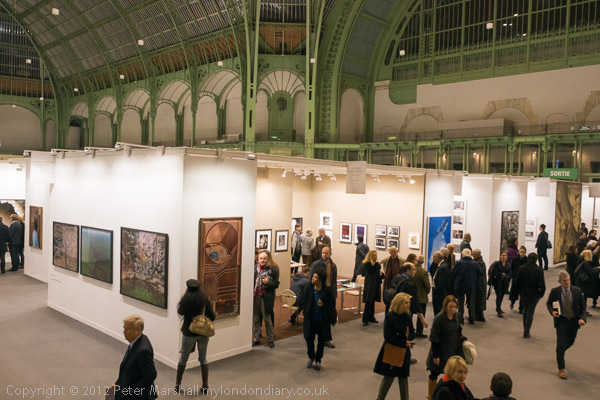
more pictures
I’d hoped to blog from Paris, but it didn’t work out - the WiFi at my hotel spent most of the week failing to connect and really I was just too busy to post anyway. Apart from the last 36 hours or so when I was considerably indisposed following a rather violent disagreement between a curry and my stomach which left me living on sips of water alone, spoiling my plans for a couple of really good meals with a decent amount of alcohol before my journey on Eurostar back to England I had a pretty good time there.
I have to say Paris Photo itself was perhaps a little of a disappointment, even though I had no great expectations. It’s certainly still somewhere where you can see an enormous amount of great photography from the past, including work by most of the real innovators and masters of the medium, but perhaps more than ever this year it showed its bias. It’s an obvious one, in that this is largely a dealer show, and dealers can only show the work that is available for sale. So, for example, a photographer like Atget was almost invisible at Paris Photo, despite his fairly huge output of work, as the great majority of his pictures were either sold by him direct to museums or became a part of museum collections - such as those bought after his death by Berenice Abbott. Other photographers, working before photography dealers and galleries really existed, seldom made more that a half dozen or so copies of any prints, and often their negatives have not survived for later prints to be made, or their estates have not allowed this to be done.
What dominated some of the stalls was work from many relatively minor figures from the post-war years who are still alive (or whose negatives are still available) being promoted because their work is available, whereas relatively little by photographers of much greater interest is still around outside of museum and other collections.
Contemporary work suffers - perhaps as always - from the quest for novelty by both photographers and in particular contemporary galleries. All too often this seems to be a turning against the peculiar link with reality which to me is at the root of interest in our medium. After a few minutes walking around the great hall containing the photo fair I never wanted again to see work in which people had painted on their photographs, punched holes in them, cut them up, processed them deliberately badly and so on. I’ve never thought showing contempt for the photograph a likely way to produce worthwhile results, but there were rather too many photographers and galleries at Paris Photo who seem to think so.
Despite the 37 new galleries and 91 that had been in previous editions, there did seem to be a dearth of exciting or even interesting new work on show. There was also a surprising lack of work by UK photographers from after the Victorian period, and several of the more interesting London galleries were not here - there were only 8 from London (including one I’d never heard of, and seeing the work they had brought I wasn’t surprised.) I met a friend from one of those missing and was told that their application to show this year had been refused. I was more than surprised given the poor quality of work on some of those who had been given space, and the large spaces allocated to some galleries with apparently fairly limited work to show.
Of course there were highlights for me - some of which I’ll mention in later posts and it was still worth attending, though certainly I’d not go to Paris for Paris Photo alone. If you have any interest in photography Paris in November is a pretty magic place, with around 80 exhibitions in the Mois de la Photo, another 100 or so in the fringe festival, the Photo Off, over 50 in the Saint-Germain-des-Pres Photo Festival, and what seemed to be countless other shows outside of these events, as well as shows of work for the Prix Pictet, the Prix de Photographie Marc Ladreit de Lacharrière - Académie des beaux-arts, the Prix Arcimboldo for creation of digital images, the Prix Carmignac Gestion for photojournalism. In six days there, most of which were spent going from show to show, I hardly scratched the surface, although apart from Paris Photo I attended seven openings, went to presentations on seven other shows, went to the Nofound Photo Fair, went into and walked around about 50 exhibitions and probably looked at almost as many through the windows and either decided it wasn’t worth wasting my time, or was unable to go in as they were closed. But there were quite a few areas of Paris I didn’t manage to get to, concentrating my time on the shows I particularly wanted to see and others in the same areas.
This was the second year Paris Photo had been in its new premises at the Grand Palais, and in most respects this was a better venue than the old underground site in the bowels of the Louvre, handy though that was for cafes and shops - and for the very pleasant gardens of the Palais Royal. It was less crowded, got less overheated and I had no problems of claustrophobia - if anything it favoured the opposite. On the downside it seemed less intimate, and certainly I bumped into far fewer people I knew as I made my way round. But perhaps with there being far less representation of living photographers from the UK and central Europe in this year’s event fewer of those I know bothered to make the journey.
I’ll write more about Paris Photo and a few of the things that excited
me there and elsewhere in Paris in the coming days, and as a part of a ‘Paris
Diary‘.
more pictures
Save Walthamstow Stadium Fight Continues
Walthamstow Stadium, London. Sat 10 Nov 2012
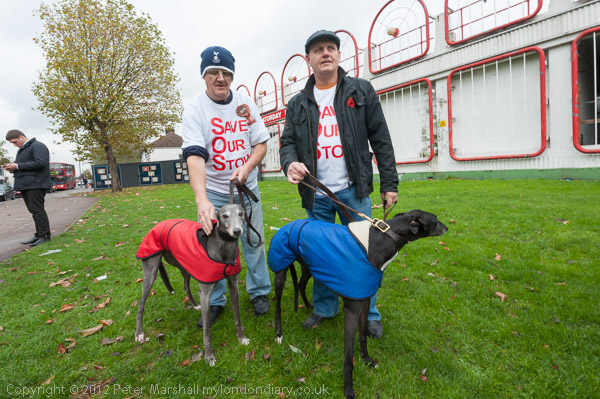
Trevor and Steve Kruse, who used to race their dogs here.
more pictures
Protesters fighting to save and reopen Walthamstow's iconic 1930s Greyhound Stadium were given fresh hope when Iain Duncan Smith announced he was to see minister Eric Pickles over the Mayor and Waltham Forest Council's decision to allow development.
The fight to save the iconic Walthamstow Stadium, opened in 1933 and used for greyhound racing (along at times with Speedway and Stock Car racing) until its closure in 2008 took yet another turn today, with the news that the Mayor of London's office had admitted a mistake involving £18 million in their calculations in assessing the development, and that Iain Duncan Smith, Secretary of State for Work and Pensions and MP for Chingford was to meet Eric Pickles, minister for Communities and Local Government on Tuesday to discuss what further action could be taken. The Department for Communities and Local Government had already been reported to be very concerned at undue haste with which the council had acted and to be looking for ways to challenge what has been seen as a snub to their minister.
The fight to save the stadium has been raging in the area since rumours of its closure and sale to developers London and Quadrant (L&Q), and the stadium held its last race in August 2008. L& Q plan to demolish much of the Grade II listed stadium and build 294 homes on the site. The local action group 'Save the Stow' has led a campaign which has even made offers at above the current market price for the site with the aim of reopening it as a greyhound track. The campaign has attracted the support of local MPs Iain Duncan Smith and the labour MP for Walthamstow, Stella Creasey and of many others in the area.
Dog racing remains a popular spectator sport in Britain, with around 35 tracks across the UK, and it claims to still be the second largest spectator sport in this country. Most of the tracks are registered and regulated by the Greyhound Board of Great Britain, which sets and enforces strict standards for greyhound welfare and racing integrity, from racecourse facilities and trainers' kennels to retirement of greyhounds. Betting is through a 'Tote' system with an annual turnover of around £75 million. Three stadia - Romford, Harlow and Crayford remain in the area around London. Although animal rights activists and some animal welfare organisations strongly oppose dog racing, and it attracted an unsavoury reputation for gangsterism, many still see 'an evening at the dogs' as good family entertainment, and insist that the dogs are extremely well-treated and enjoy the racing. And in London, an evening at the dogs almost always meant Walthamstow, which was London's largest stadium with room for over 5000 people and had the largest betting income. It was sold not because it was financially impossible to continue dog racing there, but that the high property prices in 2007-8 made it hard for the private owners, the Chandler family, to refuse offers to buy the site for development.
Waltham Forest Council passed the plans in May by four votes to three, and it was approved by London Mayor Boris Johnson on Tuesday, despite his pre-election promises to save the stadium. The council then pushed it through at breakneck speed in an attempt to avoid the normal 21 days for Secretary of State for Communities and Local Government Eric Pickles to call in the decision for review. In a BBC Radio London interview about the Mayor's decision, Iain Duncan Smith declared "people who live in the Walthamstow area are deeply, deeply disappointed in yesterday’s decisions and I am absolutely furious" and he took the matter up with the minister.
It isn't just an argument about heritage and the keeping of what David Lammy, when Culture Secretary referred to as "the best surviving and most architecturally interesting vintage stadiums in the country, and a major East London landmark" and an "architectural showpiece", there are also grave doubts both about the financial viability and the social benefits of the proposed development. The doubts have also prompted opposition to it from the Taxpayer's Alliance as poor value for the taxpayer because it seems likely that it will almost certainly result in L&Q, a registered social landlord, recieving large amounts of public subsidy. A current independent estimate suggest the housing will lose £14.5m, making the £3.8 million leisure centre and other benefits to the local community difficult to fund. The scheme is also criticised for its lack of affordable social housing. Although L&Q had orginally promised 50% of affordable homes, this has been dropped and now only 20% of the properties will be in the more expensive 'intermediate affordable class, "at prices and rent above those of social rent, but below market price or rents."
Well over a hundred people turned up outside the stadium at 1pm for a short protest, queing to sign a to back the campaign. As well as local residents there were others who remembered fondly coming to the greyhound racing at the stadium, and there were several dog trainers and a handful of greyhounds. I talked briefly to two of them, Trevor and Steve Kruse, who used to race their dogs here and who were eager for it to be used for racing again. Steve was holding the 9 year-old Luck Mentor who had raced and won a dozen races from 51 starts at Walthamstow between 2005 and 2007, and his brother Flo's Girl, too young to have raced here but who has won 3 races at Harlow. They now race dogs at Oxford. Another well-regarded dog present was Penske West, sired by Fighting Penske who has won 8 races at Romford.
After a photo-call outside the stadium there were several brief speeches.
As well as the news about the Mayor getting his sums wrong by £18 million,
I was also surprised to hear that L&Q had actually changed their plans
only 2 days before the planning committee meeting which approved them, so
few residents had actually had an opportunity to see their final plans before
they were approved. Ian Duncan Smith (the stadium is at the edge of his constituency)
told the crowd that the fight was by no means over, and he seemed very positive
about his meeting with Eric Pickles on Tuesday. The final speaker, one of
the organisers of the 'Save the Stow' campaign and this event and chair of
the Walthamstow Residents Association, Gail Penfold, told us that they had
already begun the process of calling for a judicial review of the decision.
more pictures
Stop Fossil Fuel Dirty Money takeover of US
Fenchurch St & Grosvenor Square, London. Wed 7 Nov 2012
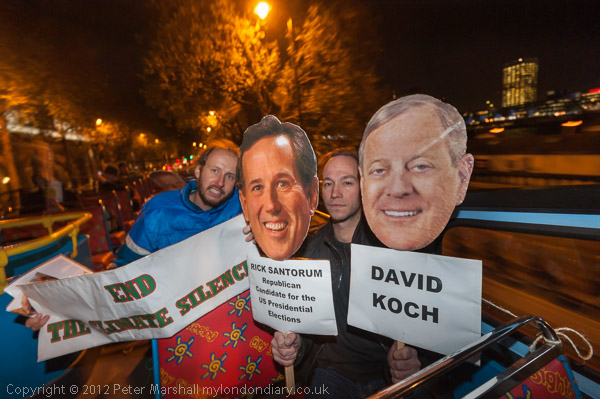
On the bus from Koch Brothers to the US Embassy
more pictures
The day the USD election results were announced, Campaign against Climate Change protested in London urging President Obama to stand up against the lobbying, dirty money and media lies funded by the Koch brothers and other fossil fuel companies.
The protest began outside the London offices of the Koch Brothers, Koch International in Fenchurch St. A great deal of interest was created by a huge banner they raised in front of Fountain House where the company, said to be the largest private company in the US has its London offices on the sixth floor. The Koch brothers have been a major source for funding disinformation on climate change and in instigating the wave of populist anti-science, anti-regulatory, right-wing extremism associated with the "Tea Party". Although the defeat of Romney represents a defeat for the extreme right in the US, the Republican Party still has a majority in congress which includes many who deny the existence of climate change.
The Campaign against Climate Change (CCC) which organised this protest talk about the 'Climate of Silence' which kept climate change off the record during the US election campaign; arguably the major problem which the world and America faces, it was absent from the debate until the climate itself forced it onto the table with 'Hurricane Sandy', perhaps an important factor in the size of Obama's majority.
The weather in London was soon causing problems for the protesters, with increasing gusts of wind, perhaps magnified by the many tall buildings around, including some giant ones under construction, made it impossible to hold the large banner, and it had to be brought down before it was carried away by the wind. The protesters then brought out a number placards showing heads of prominent US right wing politicians and media commentators, each with their name and one of their more ridiculous quotations related to climate change, along with similar heads of Obama and Romney, as well as those of the two Koch brothers, along with some smaller banners.
After an hour or more of protest, some of those present went to put banners on an open top double-decker bus hired for the protest, which then drove to Fenchurch St to pick up the rest of the protesters. The more hardy of these went up to the top deck, and with them holding some of the heads and Phil Thornhill of the CCC at the front leaning over the top with a large megaphone informing the public about the protest this drove slowly throught the rush hour traffic along the embankment and up to Trafalgar Square, then along Pall Mall and Piccadilly to Hyde Park Corner and up Park Lane and to the US Embassy.
There the police had prepared a pen in a dark corner of the square, but the protesters, after a short discussion with police were instead allowed to protest in front of the main entrance gates - which were locked as usual, with a small line of police standing along by the bollards between the protest and the tall embassy fence.
Attendance at the protest was rather smaller than had been hoped for, perhaps
because it had not been planned long in advance and there was relatively little
publicity, so the only people present were the hard core supports of the CCC.
Or perhaps many were simply fed up by the wall-to-wall overkill of media attention
given to the US election and wanted to forget about the whole thing.
more pictures
Truth, Justice and the American way?
US Embassy, Grosvenor Square, London. Tue 6 Nov 2012
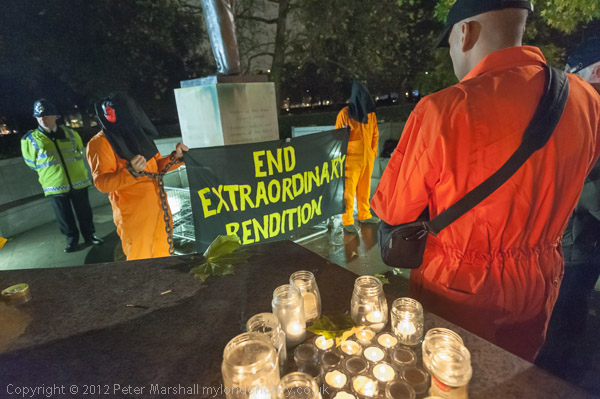
Protesters lit candles for a vigil next to the statue
of Eisenhower
more pictures
On US Election night the London Guantánamo Campaign hosted a protest outside the US Embassy at which various organisations raised human rights concerns about prisoners in the USA.
Among those who spoke at the event were Chris Nineham (Stop The War Coalition), Dr Shahrar Ali (Green Party), Joy Hurcombe (Save Shaker Aamer Campaign), Hamja Ahsan (Free Talha Campaign), Aviva Stahl (Cageprisoners), Anthony Timmons (WISE Up for Bradley Manning), Ilyas Townsend (Justice for Aafia Coalition) as well as performances by poets Miz The Poet, Ibrahim Sincere and Ed Greens.
The event took place around the statue of former president Eisenhower in front of a US Embassy lit up by a laser projection of the stars and stripes. Speakers called on whoever is elected as president to end the shameful human rights abuses represented by the continued detentions at Guantanamo and recent extraditions to the US from this country, and an end to the unlawful practice of extraordinary rendition.
Aisha Maniar, organiser for the London Guantánamo Campaign, said:
“Four years ago, a new American president, Barack Obama, promised the world a change it could believe in. One change he put his name to in writing was the closure of Guantánamo Bay and the end of military tribunals there. That has not materialised; the American administration has added drone attacks to its repertoire of extralegal activity, expanded the scope of arbitrary detention without charge or trial, and over 160 prisoners remain at Guantánamo Bay after almost 11 years, including British resident Shaker Aamer."
Noisy Demo after 17th Immigration Death
Harmondsworth Detention Centre, London. Tue 6 Nov 2012
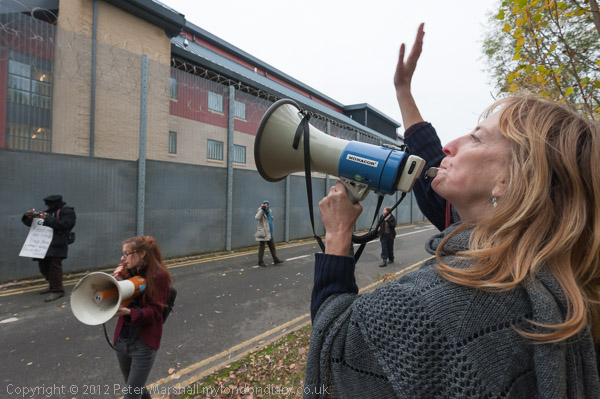
A protester waves to detainees watching from a landing
inside the immigration prison
more pictures
Protesters demonstrated noisily outside the Harmondsworth Immigration Detention Centre as the Prisons and Probation Ombudsman paid a visit following the death a week ago of Prince Ofosu, a Ghanian who died after 'restraint' by GEO Group staff.
A statement from other Ghanian detainees at the centre alleges that Ofosu sustained massive blows from one officer who has later asked to change his "blood stained clothes so that no one would notice what happened" and that the officer concerned is now on leave " in order to pervert the course of justice". After the beating, which happened in a solitary confinement room, they say that they were told by another officer who was present that Ofusu was stripped naked and the heating was then turned off and he was "left in the cold without even a duvet till his death 24 hours after being detained at the block." The statement also makes allegations about the mistreatment of other Ghanians, and the lack of proper medical care at the centre where there is no permanent doctor.
There appears to have been no proper police investigation of his death, which has been referred to the Prisons and Probation Ombudsman who is visiting the detention centre on Tuesday 6th November. The death has been referred to the Hillingdon coroner but an inquest is not expected to open until the middle of next week.
Prince Ofosu is the seventeenth detainee to die in immigration detention from from self-harm, murder, or undetermined causes, and the seventh death of a detainee in Harmondsworth IRC. An Institute of Race Relations (IRR) report in 2010 on deaths of asylum seekers and migrants which damned government policies for putting vulnerable people at risk and reported that 77 asylum seekers and migrants had died either in the UK or attempting to reach the UK in the preceding five years, of whom 44 died as an indirect consequence of the iniquities of the immigration/asylum system.
Around a dozen people turned up for the protest outside Harmondsworth and neighbouring Colnbrook Detention Centres, walking down the roadway between the two prisons. They stopped and displayed their banner and used a megaphone to let the detainees know that they were there and aware of the killing that had taken place, and read out a phone number that detainees could use to contact them. At the end of the roadway they turned to walk around the centre, and on the far side stopped again to contact the detainees.
The centres are surrounded by tall fences which make it hard to see inside, topped with rolls of razor wire, but even so the protesters could see some of the detainees inside waving to them and waving back. As the protesters outside chanted 'Freedom' and other slogans, and used the megaphone and a poster to tell the detainees their phone number, we became aware of an increasing noise from inside the prison, with the detainees banging on windows and walls and shouting back to those outside. A message of support from the women detainees in Yarls Wood detention centre was read out, and then the protesters returned to opposite the blocks where they had seen most support, and moved up onto a grassy bank opposite so they could be more easily seen from inside the fence.
The noises from inside the centre grew in volume, although we could just make out some of the Geo Limited prison officers inside trying to stop the response. A couple of the protesters went to the fence and began kicking it to create further noise, and at this the police who had been watching the protest moved in. I heard the officer in charge say so a colleague that he was fed up with this, and he told the the officers to arrest anyone who continued to kick the fence. He then approached the protesters and asked if he could talk to them without having to use his megaphone, but received a barrage of questions about the killing inside the prison, and the continuing violence being used against the detainees. He then used the megaphone to read out a warning to the protesters that they would be arrested for aggravated trespass unless they left the property, and if they returned again within three months.
The protesters decided that they had made their point and decided it was time to go, though they left rather slowly and with considerable polite argument with the police, who responded with similar politeness. The officer in charge said that he was not aware of what had happened over the killing of Prince Ofusu in the centre, and said that he would relay the disquiet that the protesters and this reporter felt about the case.
Several of the detainees had used the phone number to contact the protesters,
and I was handed a phone when one of them agreed to talk to the press. He
told me what he knew about the killing of Ofosu, but was not aware that a
statement had already come out from other detainees in the centre. The story
he told me was much the same as the statement I had already read, but of course
he had not personally witnessed the killing. This is certainly a case that
should have been investigated at the time by the police, but it appears that
Geo Group Limited had failed to call them.
more pictures
Anonymous March to Parliament
Trafalgar Square to Parliament Square, London. Mon 5 Nov 2012.
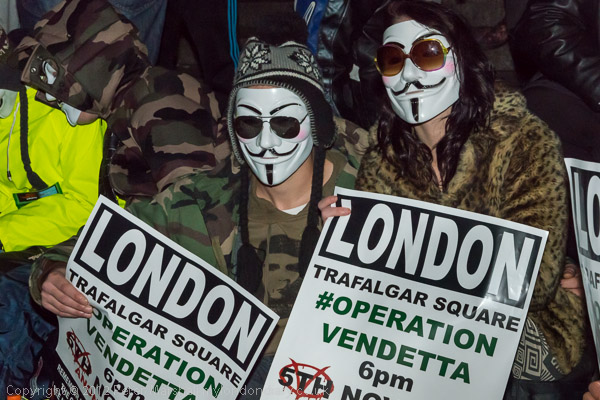
Anonymous protesters sit on the steps in Trafalgar Square
before the march
more pictures
Around 2000 Anonymous supporters met in Trafalgar Square, in a worldwide protest, marching to Parliament against austerity, the cuts and the increasing gap between rich and poor, warning the goverment they need to change.
Anonymous, a worldwide Internet-linked loose grouping of people concerned with freedom and social justice have adopted the Guy Fawkes mask popularised in the graphic novel and film 'V fo Vendetta' as their trademark, the mask symbolising the anonymous nature of their protests and its multiplicity their organisation without a leader. November 5th, Bonfire Night, was thus a obvious date for what was meant to be "a worldwide Anonymous operation of global strength and solidarity, a warning to all governments worldwide that if they keep trying to censor, cut, imprison, or silence the free world or the free internet they will not be our governments for much longer." As their press release goes on to say, their message was "Change is coming."
In the UK the protest called for an end to cuts in education, health and welfare and the end of 'austerity measures' that target the poor and vulnerable, calling on the government to tackle the causes of the problems, including the banks and tax avoidance and evasion. They also want freedom for the Internet, with respect for the privacy of Internet users and the dropping of the Communications Data Bill.
Anonymous also asks for Internet activists who are held as political prisoners to be released, including Julian Assange currently still unable to leave a London embassy, Richard O'Dwyer, the "PayPal 14, Jeremy Hammond, Topiary and the 4 anons of the UK that will stand trial on November 7th."
Hackers within Anonymous also celebrated Guy Fawkes Day with attacks on some major Internet sites, although claims by some newspapers that they had released details of some PayPal accounts seem to be untrue. But other attacks, and earlier campaigns such as those against some child pornography sites, have been successful. They say "Distributed Denial of Service must be recognised as a legitimate form of protest, as long as an aim and reason has been specified by the protestors."
Possibly around 20000 activists, a majority wearing Guy Fawkes masks gathered on and around the steps in Trafalgar Square from 6-8pm, where there were a number of speeches and performances at different points in the crowd, with rappers and others taking advantage of the several 'open mikes'. Some serious issues were raised, in particular about the activities of some social services departments, taking children away from parents in an unjustifiable way. Heritage wardens stepped in to try and stop a performance by a man using Fire Poi on saftety grounds, but soon stepped back as others entertained the crowd with them, as well as juggling with burning clubs and fire breathing. Small groups of police stood around the square watching events and taking notes.
At around 7.45, protesters moved to Nelson's column, with banners and flags being displayed on the plinth, and some directions were given for the march which was to start at 8pm. It was stressed that this was intended to be an entirely peaceful event, and that everyone should show love towards the police - the whole event had something of a 'hippy' feel to it. The march would be led by a group of people in wheelchairs.
Although the march started like this, this was Anonymous, a movement not given to following a leader, and the 'march' down Whitehall was more a chaotic movement than a march. There were a few minor scares as police vans drove a little unpredictably into the road, and one was briefly stopped in Parliament St when it was surrounded by activists who leant on its bonnet holding banners for some photographs.
In Parliament Square there was a line of police vans across the road, and a line of police in front of them stopping the marchers and directing them onto the grass of the square. It didn't have the desired effect as they just walked around the police and vans and back onto the roadway to form a crowd facing Parliament. There were a few angry exchanges between police and protesters in front of Parliament, and a couple of times an officer lost his temper at the insistent taunting and photographing by the activists, but police and other protesters soon calmed things down. Banners were raised along the fence outside the Houses of Parliament, and one young woman removed her shirt to pose in her bra. Elsewhere along the front of the square people stood around, talking to the continuing Parliament Square Peace Protest - now in its 11th year - and the fire entertainers began a show on the road in front of Big Ben.
Police formed a loose line across the road to allow traffic to continue along
Bridge St and Parliament St, but traffic was beginning to build up as their
was no way around Parliament Square. Nothing much more seemed likely to happen
so I got on a bus to make my way home, only to be held up for almost ten minutes
on a nearby junction by a 'Transport for London' lorry which had stupidly
driven onto it when the exit was blocked and could not move.
more pictures
Cleaners Protest at Tower
Tower of London. Sat 3 Nov 2012
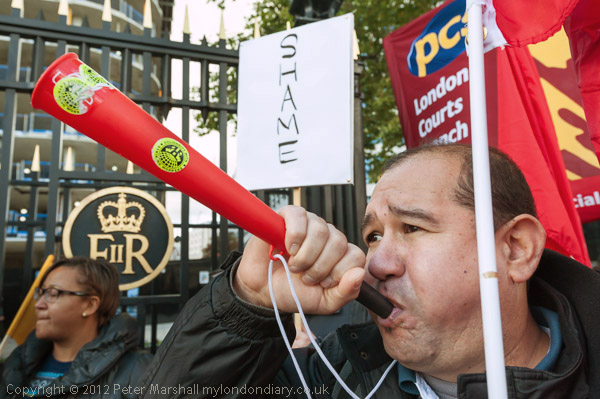
The crown, a placard with the single word 'SHAME' and
PCS banners behind a protester blowing a horn
more pictures
Cleaners at the Tower of London continued their campaign for the London Living Wage, proper facilities and contracts and recognition of their union, the IWGB, banned by contractor MITIE from all of their sites for standing up for workers' rights.
The protest was organised by the Industrial Workers of Great Britain (IWGB), the recently formed union to which the cleaners at the Tower of London belong, and was supported by trade unionists from other unions involved with cleaners including the PCS, RMT and Unison.
The protest at the main gate to the Tower was a very visible one, with approaching a hundred people involved and several large trade union branch banners and a dozen or so IWGB red flags along with some bright yellow and blue PCS ones. Many of the tourists going into the Tower stopped for a short time to watch and took the fliers being handed out.
But even more apparent was the noise. Apart from a number of speakers who made use of a powerful megaphone to get their message over, and which was also used to lead some high volume chanting of slogans, many of the protesters had plastic horns or whistles and created a deafening cacophany between those loud chants against Mitie, the contractor who actually employs the cleaners at the Tower.
The campaign here is one of a whole series around London over the past few years to get the London Living Wage for low paid workers, many of whom are still on or just above the national minimum wage - far too little to live on in our most expensive city. The campaign for a living wage enjoys wide support, including that of London's Mayor, Boris Johnson. But it still meets with bitter opposition from some of the most profitable companies around who are low pay employers, including MITIE, who last year increased their profit margins to 5.6% and had a pre-tax profit of £104.5m.
But this campaign it not only about wages, but also about civil rights, dignity and respect. MITIE seems to be treating its workers and employment law with contempt. The cleaners demand justice and fair treatment, and say they are treated as medieval serfs. They are asking for:
• the London Living Wage of £8.30 per hour
• proper contracts which reflect the actual hours of work and provide
holidays and other normal employment benefits
• adequate staffing levels to cope with the workload
• proper changing and washing facilities
• proper Health & Safety training for managers and workers, and risk
assessments of tasks
• proper safety equipment including protective gloves etc
MITIE's response to the demands has been to ban the IWGB. Senior HR Manager Kevin Watson-Griffin stated 'IWGB representatives will not be permitted access to any MITIE site, including the Tower of London, Barbican etc. to support the IWGB members who are employed by MITIE.'
One speaker from the PCS talked about the success of the cleaners at another Crown property, Buckingham Palace, where a campaign last year had led to the cleaners getting the London Living Wage. Journalist Owen Jones also encouraged the cleaners with stories of successes from action by workers, including that of the electricians who fought and defeated proposals to de-skill and lower pay for electricians in the building industry. Several speakers stressed the importance of a united campaign by low paid workers, particularly cleaners, across the trade unions to fight companies such as MITIE, where cleaners on different sites run by them were in different unions. They also identified outsourcing as the major reason for poor pay and conditions, enabling bodies such as 'Historic Royal Palaces', the charity which runs the Tower of London and other royal palaces for The Queen to try to evade their responsibilities for the welfare of those who work on their premises.
The protest had started a few yards outside the large double gates to the
Tower precinct, but soon surged through one of them, where Tower security
men told them they were not allowed through. They stopped, but didn't retreat,
and the protest continued for almost an hour on both sides of the gate. Tourists
were still able to come in and out as the other gate was left clear, apart
from a few people offering fliers to those coming in and out. Shortly after
the protest finished, and people were standing around talking outside, a couple
of police arrived and the gates were shut.
more pictures
top of page
All pictures on this section of the site are Copyright © Peter Marshall 2012; to buy prints or for permission to reproduce pictures or to comment on this site, or for any other questions, contact me.

